The night had been cold, clear and incredibly silent, except for the odd semi-trailer or car which came thundering out of the black moonless night. The morning was also cold, the kids insisted that they needed hats and gloves. Finding these items was a pain in our necks - we were also trying to feed them breakfast and pack up so that we could hit the road.
We pulled out onto the Eyre Highway on the Nullarbor at 8:00 AM and headed west.
Our first stop was climbing the Madura Pass where a brilliant view of the Nullarbor below was waiting to be recorded.
The scenery changed little: flat country side; saltbush and scrub for as far as the eye could see. The wildlife consisted of animals in 2 categories. Category 1: Dead including rabbits, but mainly kangaroos in various stages of decomposition. Category 2. Alive, including ravens which were very common and wedge tailed eagles which were rare. This second category was only visible because it was feeding on the first category. Ravens are smarter than wedge tailed eagles as I saw several of the latter splaticated and none of the former in the same state.
At Balladonia we stopped at the Roadhouse. Most places on the Nullarbor are roadhouses, motels or pubs.
The kids enjoyed running around and playing on the well-equipped climbing frame, while I filled the car from the 20-litre jerry can. Fuel was $0.89 per litre.
Parked nearby were about 6 huge semi-trailers, most of which were roadtrains.
One of the drivers was servicing his rig. I struck up a conversation and before long the whole family was there talking about the trucking business, animals on the road, family life and the cost of buying a truck. Eventually, we all piled into the driving seat looking down on the exposed 440 horsepower cat turbocharged 6-cylinder diesel engine capable, said the driver, of 145 clicks.
The Eyre highway continued to slice through the saltbush plain, and we drove through this environment for hour after hour. We stopped for lunch at one of the water tanks beside the road. Anja and Rohan were sound asleep so we didn't disturb them, making sandwiches for them before continuing.
A certain amount of distraction was produced by the Fraser range - a series of low hills where the road changed direction. Just before these hills we had stopped at a roadhouse, that I cannot recall the name of, for fuel. Looking to pay I had asked a likely looking bloke if he worked here. He answered that no, he did not work here, but he had been stuck there for 3 days working on his Ford truck which had required a new harmonic balancer, fan and radiator. Apparently, the fan had fallen to pieces and destroyed the rest.
The parts had arrived at 2:00 AM the previous evening and he had been working all day putting the new parts in. “I ain't no mechanic but I'm sure as hell learning” he said in his southern American drawl. While the kids played, I wandered over to see how he was going. “Ford are shit in the (United) States and they are shit here” he said as he hefted the 20 litre plastic jerry can of water up to the filler tank.
Shortly after adding water to the cooling system, it started dribbling from a round hole behind the fan. When he had a look, he said a small lead ball in the body of the water pump had melted, indicating the pump had overheated. A new pump would be required. With an obvious effort of will he didn't punch anything, rolled a fag and strolled to the phones to tell his boss the good news. I wished him luck. What else could I have said to someone who would have to wait here for another 3 days until the water pump to arrived?
As we travelled nearer to Norseman, the saltbush changed to scrub and gradually the stunted trees stretched up to appear, to us, as normal woodland.
At Norseman we exchanged what remained of our money for fuel, bought the kids lollies and visited the nearby park before heading for Esperance, 204 kilometres to the south.
Entertaining the kids proved difficult during this phase, but we had decided that travelling the extra distance to Esperance was preferable to setting up camp twice in as many days. Arriving in Esperance at around 7:00 PM we voted for Chinese food, paid for by our BankCard, before pulling into the shire van park. This was the end to, what would turn out to be our longest day of travel during our trip – around 800Km in total.
Thursday 29th March 1990
First on the agenda was fishing off the, now disused, tanker wharf, which points, like a long bony finger, into the relatively calm waters of the Bay of Islands. [2020 note: this jetty is no longer used and has been dismantled – see here for more information] Walking about halfway along its 0.5Km length, we learned a lot about fishing for herring and squid by watching what the locals were doing. We had bought 2 squid jigs at Streaky Bay thinking they should be used as lures. We were wrong - they should be used as shown in the diagram below
 It is now clear that we were wasting our time using the jigs as lures. As far as herring are concerned burley is all important. This burley should be made from whale oil - yes you could buy it! - mixed with pollard. This mixture is compressed around the bait and falls off gradually when in the water, attracting the fish and keeping them attracted to your bait. Once we had mastered the technique, thanks to a kindly lady who was happy to share her expertise, Jacqui caught 1 herring, half as many as we had been generously given by the locals to load our squid jigs.
It is now clear that we were wasting our time using the jigs as lures. As far as herring are concerned burley is all important. This burley should be made from whale oil - yes you could buy it! - mixed with pollard. This mixture is compressed around the bait and falls off gradually when in the water, attracting the fish and keeping them attracted to your bait. Once we had mastered the technique, thanks to a kindly lady who was happy to share her expertise, Jacqui caught 1 herring, half as many as we had been generously given by the locals to load our squid jigs.
Walking back along the jetty at lunchtime we were treated to a fantastic sight. A big sea lion, with brown fur and a yellowish mane waiting for the remains of the fish cleaned on the table near the shore-end of the jetty. This fellow obviously was a regular, spending most of his time with head out of the water watching for the arrival of fish cleaners.
Large schools of small fish swam around this sea lion, most of the time at a respectful distance, in a circle. This gave the odd appearance that he had a halo. Even the pacific and silver gulls stayed away from him. Everyone enjoyed watching this wild creature and we stayed for nearly half an hour before Jacqui naturally gave the sea lion our only catch of the day and we headed into town to shop for supplies.
During the afternoon, a very strong southerly wind blew up and most of our time was spent indoors. After tea, we rugged up and walked the short distance to the jetty, where, to our amazement, the sea lion still waited. Many people were fishing, so he was still being fed.
Friday 30th March 1990
It's not often that we fill 1½ Hills Hoist rotary clothes lines, but today, after having not washed for five days, that is what we did.
In the afternoon we did a little more shopping - we are born to shop! - and then drove 53Km to beautiful Cape Le Grand National Park. Here, bold granite peaks emerged from a low heathland with strange gymnosperms-like plants poking out to a height of 2-3 metres.
At Lucky Bay, the wind was too strong for a dive, which was unfortunate as I'm sure it would have been interesting. In this bay the granite dipped into the water at around 40 degrees, apparently being unaffected by the action of the waves, as no rock platform could be seen. Either the formation is extremely young, or very resistant to weathering and erosion by wave action.
In many respects Cape Le Grand reminded us of Freycinet National Park in Tasmania, except here has a more gentle slope of the hills, and a significantly larger area - the same blue sea and white sand were present at both locations. Another similarity hopped into the car park in the form of about 6 wallabies, obviously used to receiving food from visitors.
Baked leg of lamb for dinner was yummy, after which Jacqui and Lachlan went to the jetty to try their luck fishing for herring again while I looked after Anja and Rohan.
After putting on a music cassette tape to keep them occupied, I decided to make a cup of coffee. Pouring water from our two-litre jug, I was not put off by its brown tinge as the water tank contained water from Streaky Bay – where clear drinking water was unusual. When I made my coffee, however, the milk curdled. I had been using diluted Apple juice instead of water!
Saturday 31st March 1990
After packing up and doing some washing and shopping, we spent most of the morning fishing from a small jetty attached to a rock wall near the centre of town.
The day was warm and sunny, cooled pleasantly by the breeze off the Bay of Islands.
Jacqui was determined to catch some fish and was furious that, after several hours of effort, 1 was all she could claim.
Before we could leave Esperance however, we needed petrol and WA still has a roster system for service station openings on the weekend. We queued for 15 minutes at the one open service station, filling up and leaving at 2:00 PM.
We followed Hwy 1 through Ravensthorpe and onto Jerramungup. most of the time through wheat/sheep farms although here, unlike in South Australia, there were a few tracks of natural scrub. One such area had recently been burnt and smoke could still be seen from a few smouldering pockets of bush. The heat had been so intense that it singed the trees a road width away.
At Jerramungup we phoned NP&WS to investigate camping in the Fitzgerald National Park only to be discouraged because the roads were too narrow and rough. So we decided to head to bremer Bay.
Before we left the roadhouse/pub/motel at Jerramungup we watched a road train of sheep being assembled. That is to say the trailers full of sheep were being linked. The trailer which tags along behind the prime-mover had obviously been in that spot for some time, judging by the volume of sheep urine and faeces around its perimeter.
About an hour later we were at Bremer Bay and was shocked to find the price was $18.00 per night which was calculated by $10 + $2x4 dollars. Amazing! We took one night only.
Sunday 1st April 1990
I think it's fair to say that when Jacqui starts reading a book she enjoys, not much else gets done until it is finished. The previous evening she had gone to sleep late and this morning woken up early, with a little help from three small friends, reading Not a Penny Less by Jeffrey Archer.
We left the caravan park and purchased a block of ice for $2.50,then drove to fisherman's beach near Bremer Bay. As the kids swam in the cool clear waters which lapped quietly against the pure white sand, I investigated a derelict Steber 34 type fishing boat at the other end of the 50 metre long beach. When I returned to Jacqui, I found her buried in her book, so I remarked the fishing boat was still full of live crayfish. She simply murmured and continued reading.
That night I raised the subject of April fools’ jokes and she said she had never heard me mention the boat. See what I mean about Jacqui and books!
When the book was finished, I went for a dive just off the shore where the granite-like rocks dipped into the calm sea. After nearly an hour I emerged with some large fish and a few smaller drummer, leather jacket and mowong. The biggest was about 50 centimetres long and of a species unknown to me.
While cleaning the fish we spoke to an ex-shearer who now owns two properties of 6000 acres nearby, running wheat and sheep.
We filled our bellies and then hit the road. Before long everyone, except me, was asleep. I managed to wake Jacqui when we got a flat tyre on the curb side van wheel. It was changed with little difficulty and we headed once more to Wellstead where we phoned home. I intended to ring my uncle Max, but the phone was so full of money it wouldn't take ours. Jacqui was angered by this as it meant we could only ring home reverse charges.
From there it took only 20 minutes to reach Cape Riche and find a camping spot among some trees only 50 metres from the water.
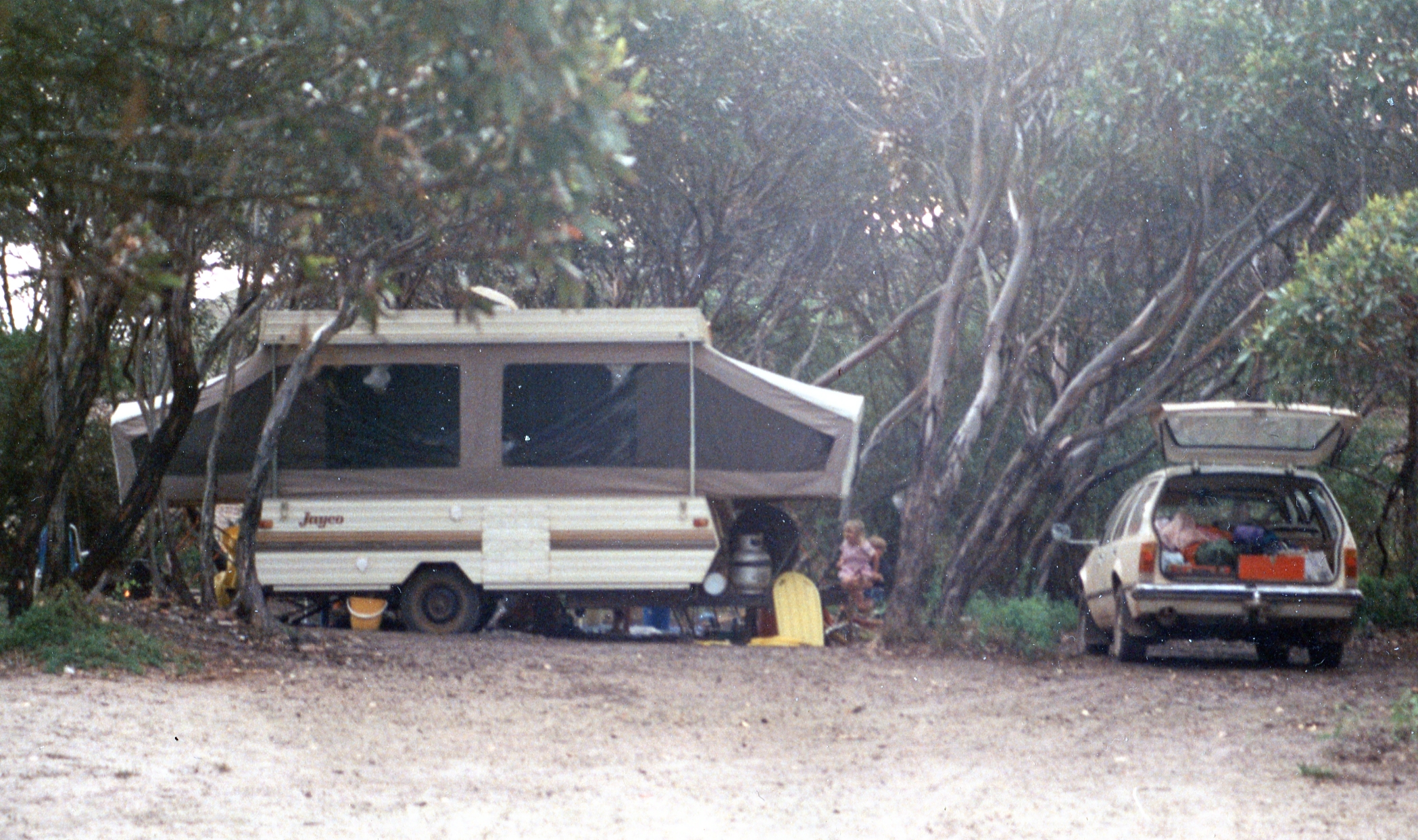
After getting dinner underway we walked along the shore, discussing fishing techniques with two young blokes we met. They drove us home in their ute and gave us a bag of bait for tomorrow.
This place is worlds away from the Nullarbor with waves crashing and, unfortunately, a generator blaring from other campers. Yuck!
Monday 2nd April 1990
After a lazy morning, during which I read while minding Anja and Rohan, and Jacqui went fishing with Lachlan, I received a Royal command. Jacqui had sent Lachlan to get me, she had lost her squid jig and it was my task to dive for it!
I packed my diving gear and with the kids went to Jacqui's fishing spot atop a large granite rock adjacent to the sea.
Shortly after entering the water I found the jig and Jacqui threw me my spear gun. All around where Jacqui had been fishing, schools of herring and other fish swam, there for a free feed from our baits, no doubt.
As we had a fridge and freezer full of fish, I was only searching for bigger prey. After 20 minutes I spotted the tail of a big fish, the same as the one I had caught the day before, in about 20 feet of water. He didn't move so I could got a good shot and hit him in the head. He was very strong and fought valiantly, in fact the spear pulled out and I was forced to reload and spear hit him again before getting him on my line. [2020 note: I can recall catching this fish and I remember feeling regretful about catching such a beautiful creature]
Returning to Jacqui, just in time to feel the wind really pick up from the north which was onshore, I cleaned and filleted the fish and we beat a hasty retreat back to the van. Both of us got wet trying to retrieve the top of our bucket which fell down a narrow crack in the rock platform.
On the way back we met four blokes cleaning herring, which they had bought from the commercial fishermen. In all they had bought 32 dozen for around $40, and a large box-full that was! We had seen, from a high vantage point, the fisherman retrieving the nets that morning off the beach. We were told they are paid $250 per tonne. This morning they had had to let 2 tonnes go due to large amounts of weed in the net.
After lunch Lachlan did some correspondence lessons and then we went to Wellstead for supplies, picking up five firewood from the side of the road on the way home.
The fish was very tasty, and two fillets fed everyone.
Tuesday 3rd April 1990
This morning we left Jacqui to some hand washing as Rohan had wet his bed even though he was wearing a nappy, and walked about one kilometre along the white, squeaky sand, beach. We ended up where we had seen the fisherman yesterday using a big net to catching herring. The kids enjoyed a romp in the sand, and we saw a few interesting things including the cliffs which had fascinating geological structures.
We also picked up cuttlefish, one of which had apparently fallen prey to a dolphin. Part of the shell was bitten away and near this bite mark was a second set of circular teeth marks, paralleling the bite line. The kids were fascinated.
In the afternoon I changed the oil in the car and gave Lachlan a correspondence lesson. I also went diving for two squid jigs, both of which had been lost while casting out when the line broke. I suspect this happened because the fish used for bait with too heavy for the line on Lachlan’s rod.
I didn't take my gun but looked instead for shellfish. None were to be found but I did see an even bigger version of the fish I had speared the previous day.
As I write at 9:10 PM it has started to sprinkle heavily, and if this keeps up it will make the pack up in the morning very muddy!
Wednesday 4th April 1990
It didn't rain too much overnight, but a few showers during the morning succeeded in making the pack up one of the more memorable. Imagine, if you will, black sandy mud which sticks to the soles of your shoes and slowly accumulates as you walk around, resulting in a gradual increase in your height. Coupled with this, the mud got all over everything, a situation made worse by more short rain showers. Packing up was bloody awful!
Eventually we got on the road at 9:00 AM and made for Albany: note don’t pronounce it "Allbany" or the locals will know instantly that you aren’t from WA!
Somewhere between Wellsted and Albany, but closer to Albany, the country abruptly changes from dryland farms to green fertile country, reminiscent of the South or North Coast of New South Wales. The trees are taller, the grass is green, and the air is moist. It was like going home after the last month or so in very dry conditions.
At Albany we spent most of the day shopping, washing and organising money. I also had to get a new tyre for the van, as the old one had a large hole in the side making it unrepairable.
During our lunch break we stopped off at a museum near the harbour and looked over an old sailing ship which is now on dry land. There we bumped into Gary, Fiona and their children Sam and Hannah whom we had met first in Eucla. They had been here in Albany for several days and said they still had numerous things to see. Even though we spent most of our time aboard the Amity talking to Gary and Fiona, we did have enough time to look over the ship. We marvelled at the cramped conditions which had been endured by those who sailed in her.
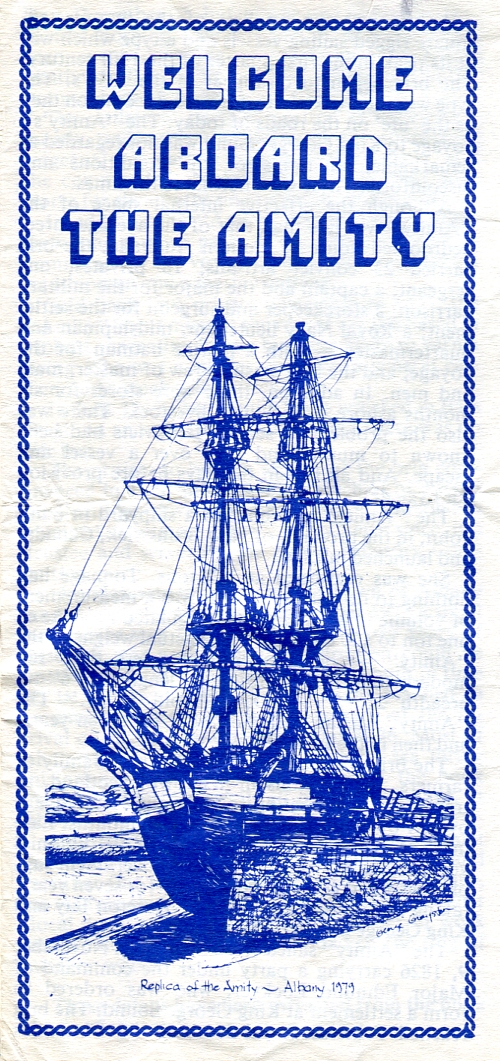
From Albany we travelled through green rural land to Denmark and Walpole, before entering state forests and eventually Shannon National Park.
Beside the road in the diminishing light, we could see the pale, ghostlike trunks, of huge towering karri - eucalyptus diversicolor. The other trees present and equally as tall are jarrah - eucalyptus marginata, and marri - corymbia calophylla.
At the old Shannon townsite we found a passably level site. Locating this camp site was tricky in the fading light. Our spot was amongst all sorts of introduced trees planted when the area was a mill town. The mill closed in 1970 and all the houses have been removed. However, the depressions, concrete slabs and stairways remain as a reminder of what was previously there.
Thursday 5th April 1990
Waking before everyone else at 6:30 AM, I walked around seeing our site and the camping area in daylight for the first time.
I collected some wood and lit the fire for breakfast before we all traipsed off for a pre-lunch walk. It took about half an hour to get to the dam which was a source of water for the mill and town. The road wound through regenerated areas and amongst magnificent mature examples of karri and jarrah.
From the dam, we walked back along the track which follows the Shannon River, which is more a series of interconnected waterholes than a river. The path was well signposted and had informative noticeboards at strategic intervals. At the dam, the kids collected clay which we carried back to make into pots and things upon our return.

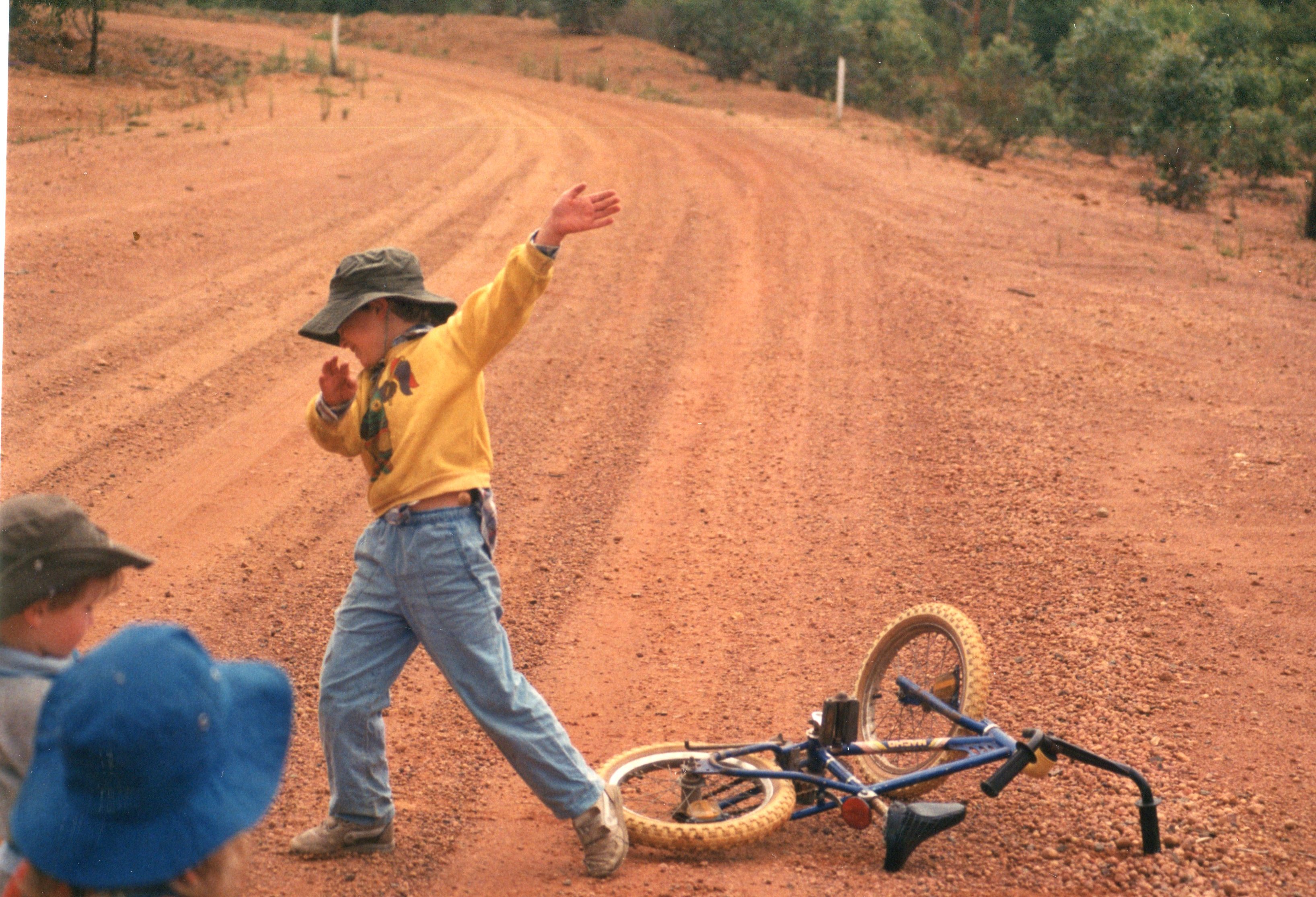
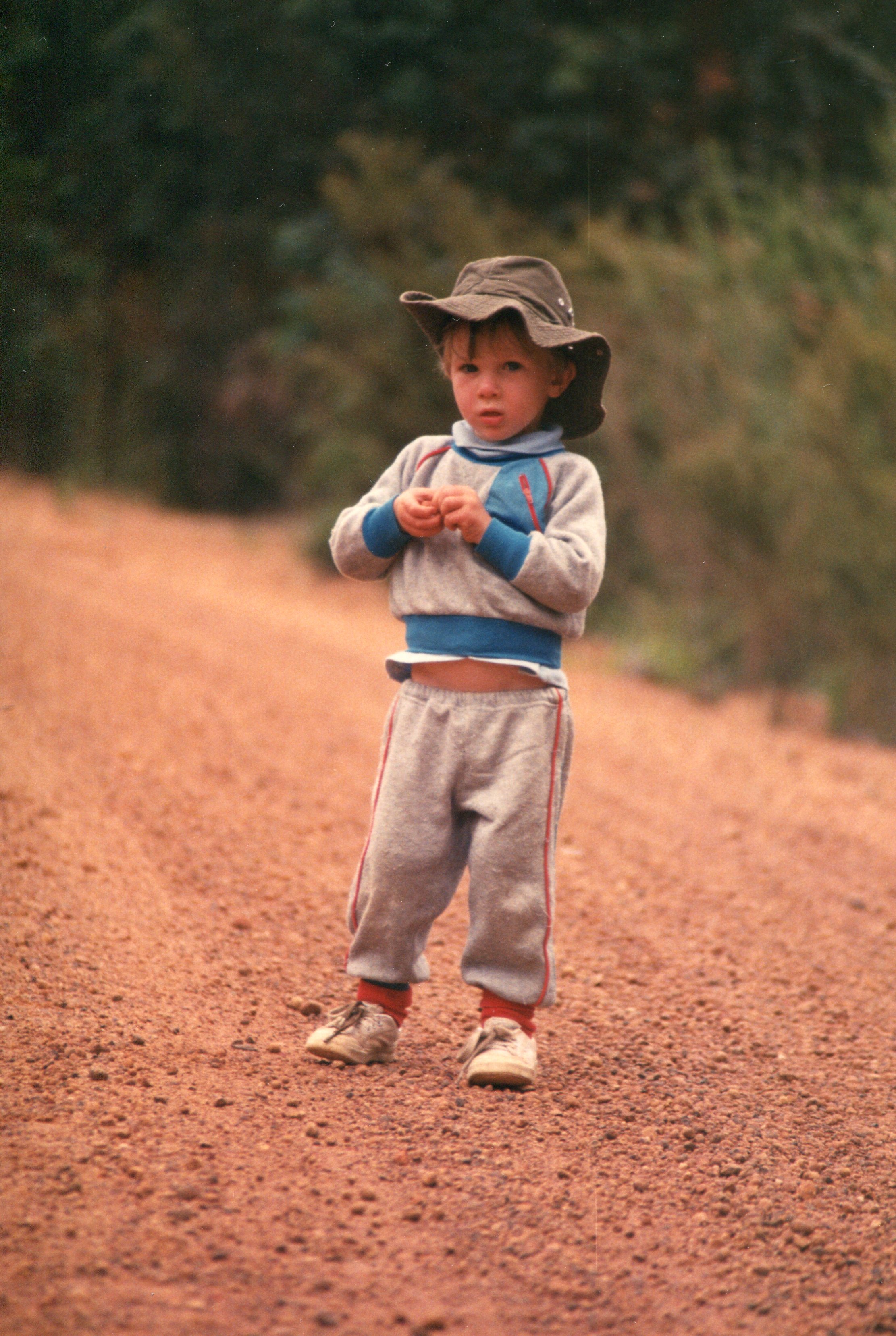
Walking back to camp from the Shanon townsite dam where the kids had collected clay to make pots and other things
The Ranger was here clearing out the toilets. The shower is heated by a chip heater so he was also depositing wood for the barbecues and chip heater. The wood left to burn in the water heater and in our campfires is off cuts of jarrah and karri from the working sawmill. I collected a nice piece to make into a breadboard when we return home.
One of the prerequisites for a job as a Ranger must be the ability to talk to people for long times as this is just what our Ranger did.
We also spoke to two other groups of campers, one with a Land Cruiser and a Sunwagon camper trailer and the other in an old Brisbane bus, both of whom are travelling around the country. We shared many common experiences, although the people in the bus had been on the road for 2 years.
Friday 6th April 1990
The day was still and clear. At first we decided to visit the coast, but sitting around reading, while the children amused themselves, got the better of us and we stayed “home”.
John and Beryl, fellow New South Welshman, camped nearby. They were worried about whether they had enough fuel in their car to get to the next service station. I offered to give them some of ours. John arrived with a small plastic tube whose internal diameter was only a few millimetres. In any case it wouldn’t reach the fuel in my tank as it kept curling up, so we were unable to syphon any fuel. As it turned out a quick examination of a map showed the nearest town, Northcliff, was only 29 kilometres away. John hadn't looked at a map and didn't know this.
We then went to John’s caravan to light the fridge; which John had been trying unsuccessfully to light since the previous evening. I bled the pipes of air and eventually got it going - the main problem is the stupid system of mirrors required to see whether the pilot light is alight: during the day it is almost impossible to tell if the pilot light is on or not.
Next job on Johns list of repairs was to replace a bolt on one of the caravan support legs which had vibrated loose.
Finally, I explained to John how their shovel, an army fold-out type like ours, can have the spade part fixed in place by turning the locking collar. John complained that it had been useless, until today, as the blade flapped around without the collar locked! John was retired and had previously worked for the Australian Taxation Office as a tax assessor. I hope he was better at tax assessing than he was as a handyman!
After completing John’s list of repairs, we heard how they had rolled their caravan near Mount Isa last December (1989). Subsequently they had to wait in Mt Isa for 3 months for the repairs to be completed. Beryl explained how it happened: she was driving, and a bus passed at high speed. She had pulled off the road at 60 kilometres an hour and lost control when attempting to drive back onto the road and the caravan rolled. The damage can’t have been that bad or, I'd imagine, the insurance company would have written it off.
After an afternoon of inactivity, we spoke to Sandy and Simone who arrived in their Land Rover with trailer. Sandy is an ex-pilot for IPEC [2020 note: IPEC was a large transport company that included air freight]. He is now unemployed and travelling around Australia for 10 months with their 3 children, 2 of whom played with Anja and Rohan. The children were Chris who was Seven and Sigrid who was four.
That evening we sat around the campfire, and solved the world's problems while sipping on lumpy Baileys, Best’s white port and white wine - an interesting combination of drinks that, no doubt, made the solutions to complex problems appear straightforward.
Sandy, as I mentioned, is an ex-pilot and one of the few who voted against the current pilots’ strike. [2020 note: as pointed out previously there was a strike of pilots going on – they were seeking better pay and conditions]. Sandy said 95% of the pilots had voted for the strike and it was true that they had been warned about a “non-income-period”, but I suspect that they had not anticipated losing their jobs in the dispute.
The kids went to sleep on our laps and we put them to bed in Sandy's Land Rover. About an hour later we heard a squeal which sounded like a wounded cat. Anja had woken up, frightened by her strange surroundings.
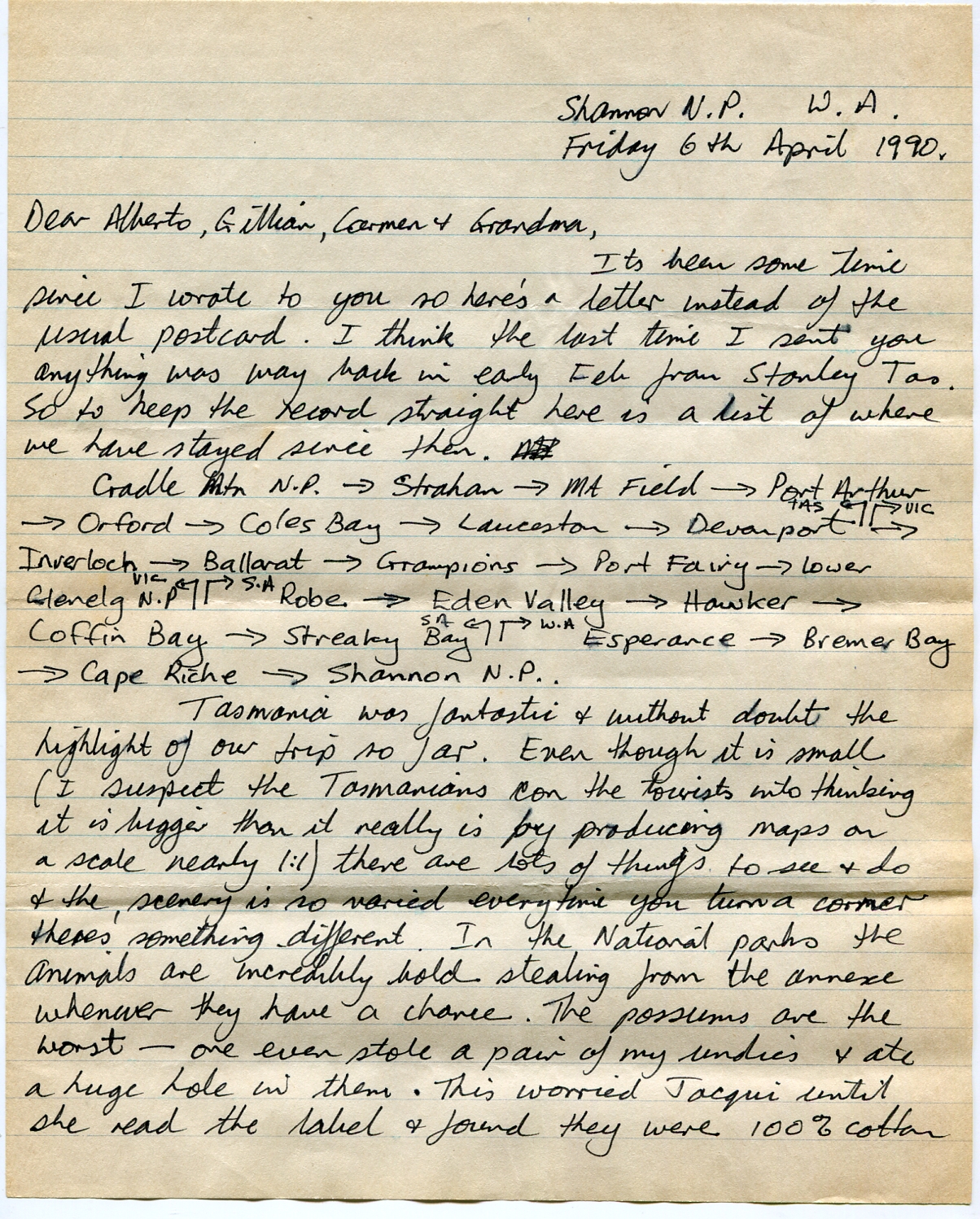
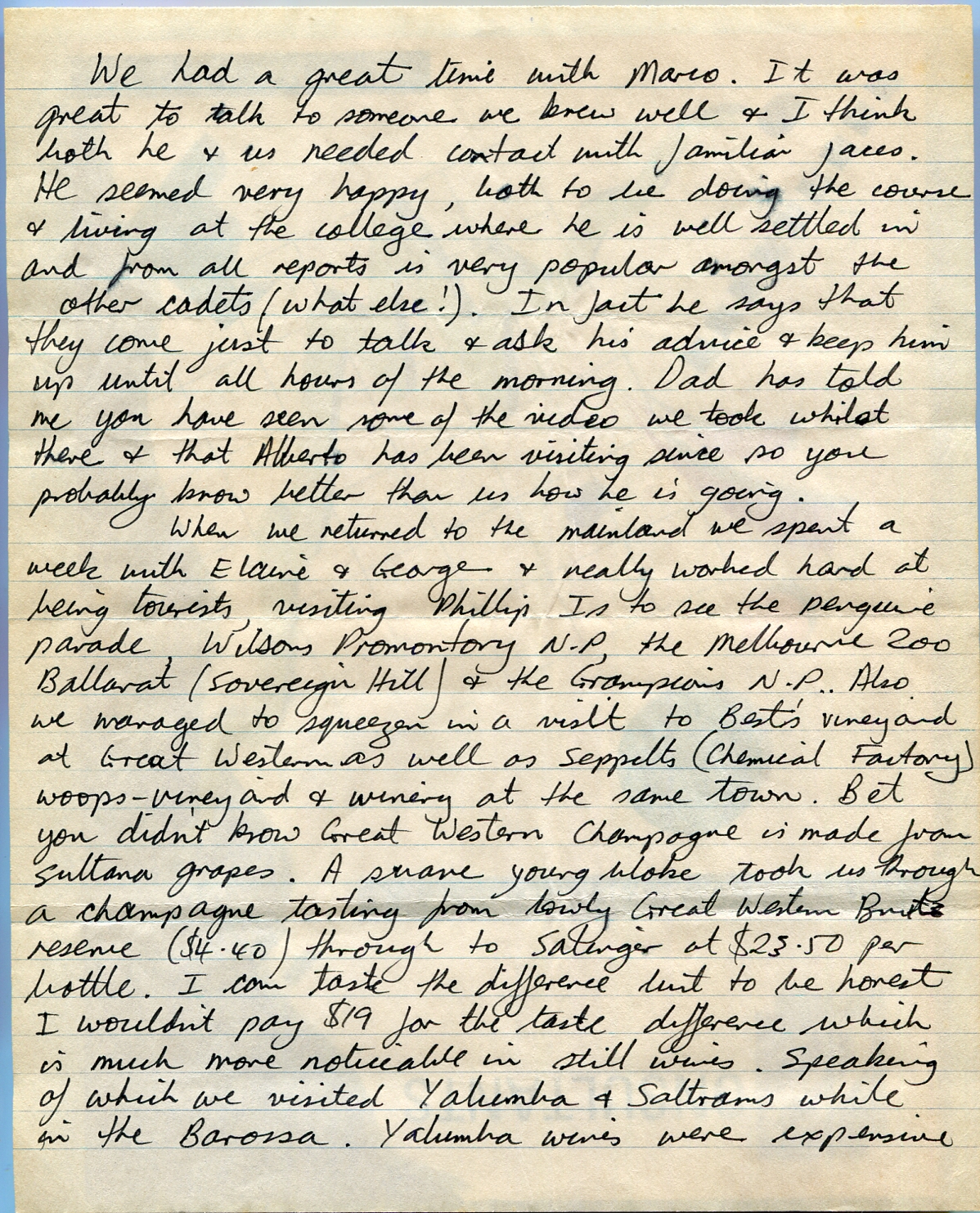
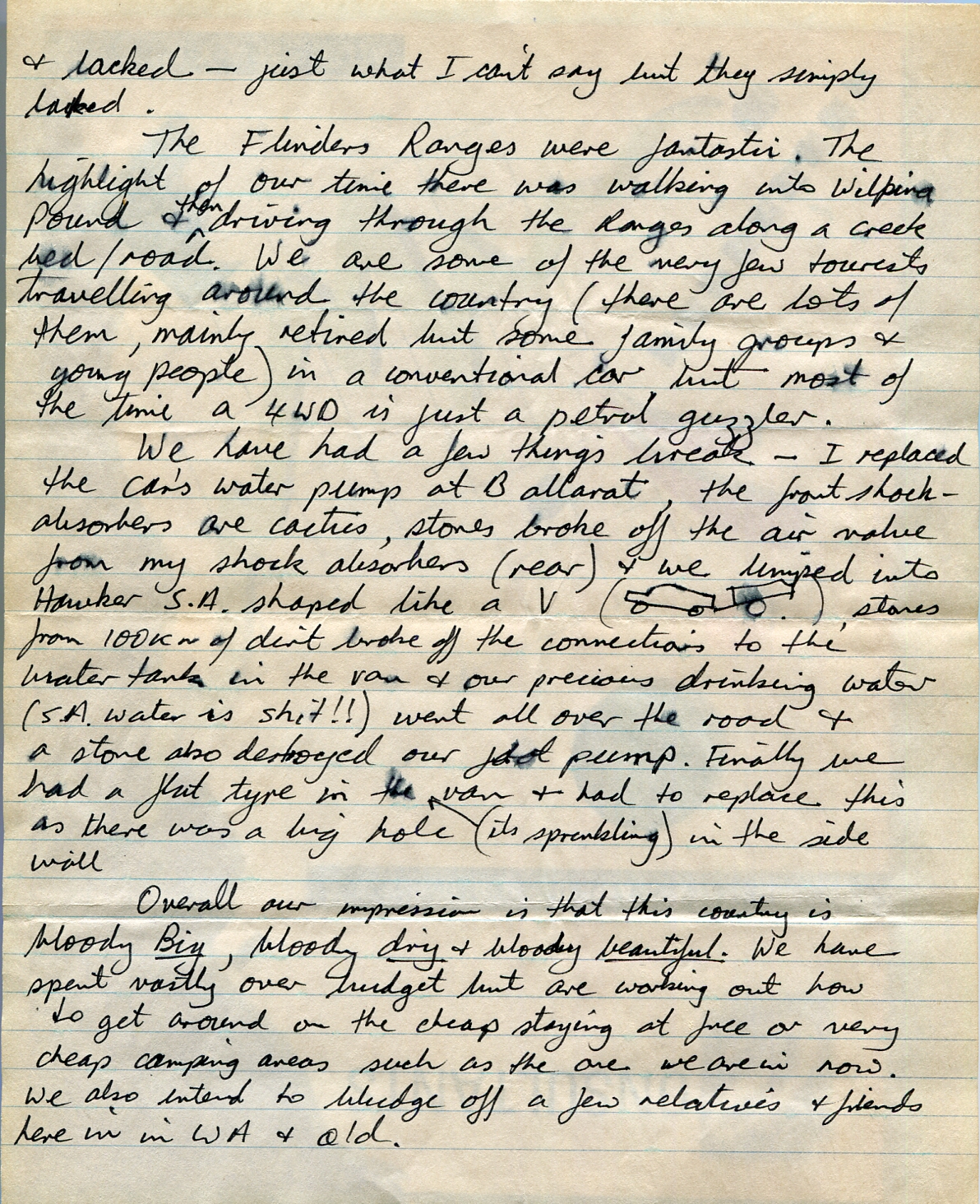
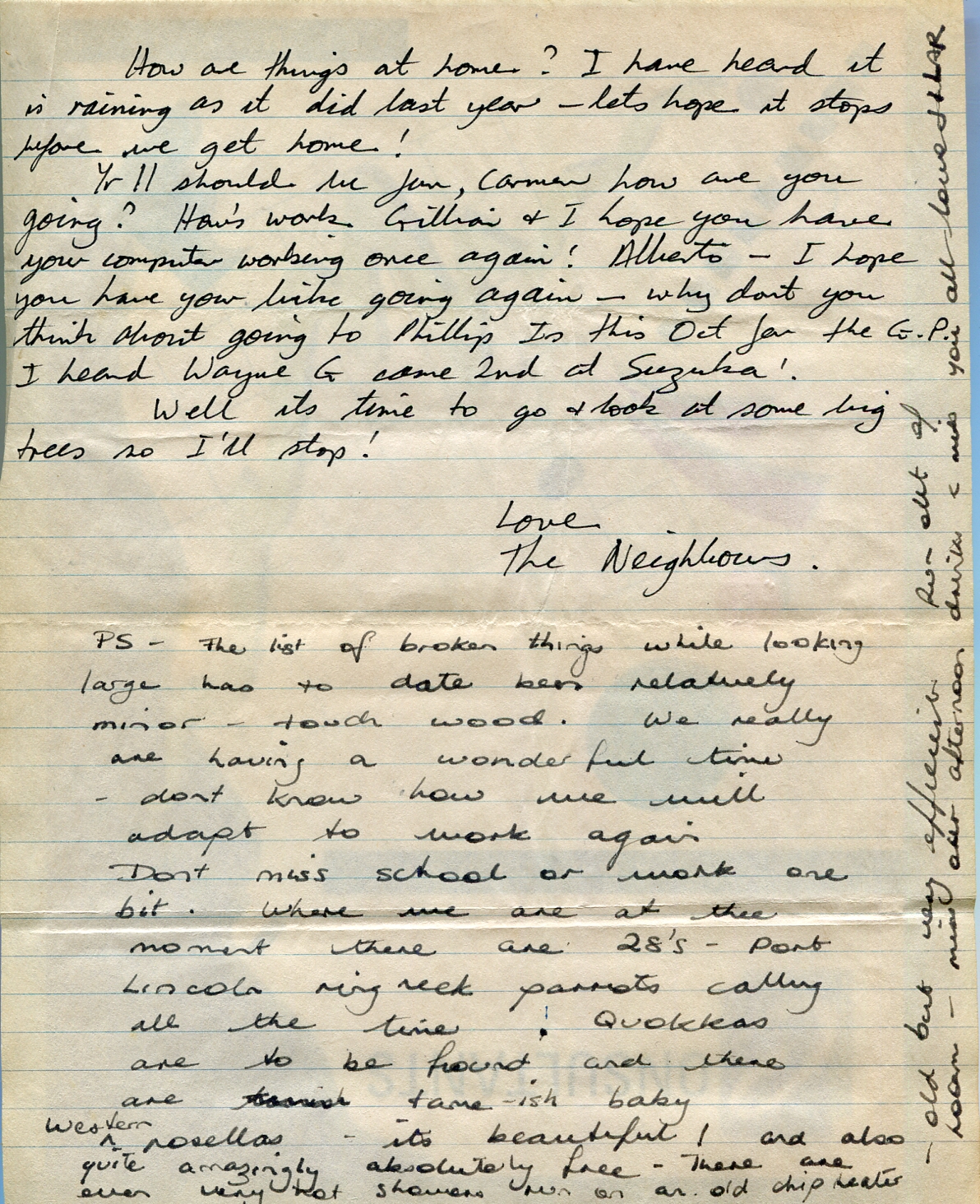 This is a letter Ian wrote in Shannon NP to our then next door neighbours, Gillian Workman and Alberto Blanco, their 2 children Carmen and Marco and Gillian's mother Hilda Workman
This is a letter Ian wrote in Shannon NP to our then next door neighbours, Gillian Workman and Alberto Blanco, their 2 children Carmen and Marco and Gillian's mother Hilda Workman
Saturday 7th April 1990
First stop, as we travelled to Max and Joan’s, was the Gloucester tree at Pemberton. [2020note: Max is Max Nethery, Ian's uncle on his mother’s side. Joan is his wife.]
Lachlan was keen to climb the Gloucester tree: a huge karri 61 metres high.
Climbing involved standing on alternating steel and wooden spikes driven into the tree, following a helical path, to the lookout tower perched on the tree’s top. After ascending about 5 metres the rungs were surrounded by an open steel mesh. A slip would still be dangerous as the space between the rungs was 50cm.
Lachlan climbed well, but after we had gone 10 to 20 metres, he decided it was a long way down and continuing to climb wasn't for him. I was pleased he decided not to proceed and praised him for his sensible decision.
Jacqui was next and at around halfway up or 30 metres, was stalled by another climber who was acting the goat for photographic purposes. During the pause she had time to contemplate the view to the ground and decided to come back down.
I was the last to have a go and made it to the top. The fall worried me somewhat, and I had a firm grip on each rung and made sure my feet were firmly planted before stepping to the next rung. The view from the top was good, but not spectacular as I had anticipated, since the top of the canopy wasn't far below, and thus the sensation of height wasn't strong. Only when looking vertically down was the height emphasised.
Connected to the tower was a one-centimetre diameter steel cable which curved to the ground far below. A pulse could be sent down by giving the cable a pull. It was fascinating to watch the pulse snake off down the cable and soon come back after being reflected at the base.
We arrived at Max and Joan’s after a 2-3 hour drive, at around 4:30 PM.
Max is the lighthouse keeper at Cape Naturaliste. Before coming to this lighthouse, Max was the lighthouse keeper at Cape Leveque which is at the end of the Dampier Peninsula, a 200Km drive north of Broome.
[2021 Addendum: Anja, Dallas and Arliah visit Cape Leveque during a trip around Australia]
Here are some photos from there trip to Cape Leveque from Broome.
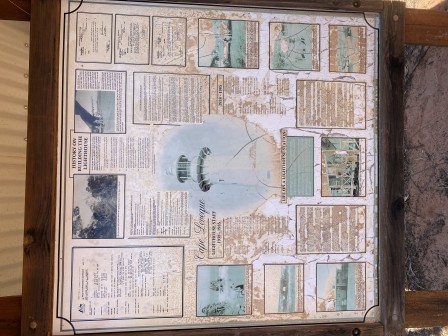
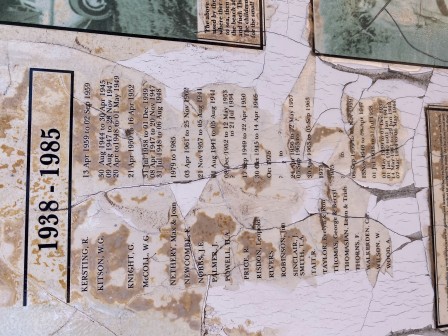
Max and Joan were well, and after our arrival we sat around on a covered paved area Max had built off his house, the third stone house in a row of three built for the original lighthouse keepers.
At 6:00 PM, Max took us to the light to “light up”. We climbed the green painted wooden block stairs without holding onto the brass rail as that would tarnish it (Max would walk up the stairs holding onto a cloth wrapped around the brass rail to polish it), and out onto the observation platform just below the level of the light itself.
From here the Indian Ocean stretch placidly from the Southwest to the North, the land visible being low heath of the Leeuwin-Naturaliste National Park.
The light itself is a 1000-Watt, 120 Volt quartz iodine globe which stands 15cm high. In many ways the globe was like an overhead projector bulb. The beam of light is produced by a two-metre-high multi-element fresnel lens which sends out two beams 180 degrees apart. The whole lens rotates once every 10 seconds giving the Naturaliste light its characteristic two flashes every 10 seconds. This, Max told us, is a fast flash rate for a conventional light
The lens housing floats on mercury, with a huge ball bearing to give lateral stability. Max starts the rotation by hand after removing the blinds which stop the lens concentrating the sun's rays during the day. He then switches on 2 electric motors, both about the size of a car starter motor, which are individually capable of driving the lens if the other fails. If the light fails, or the motors stop, or run at the wrong speed, Max is notified by alarms which ring in his home.
Max’s job basically revolves around maintaining the light itself as well as the lawns and buildings of the lighthouse keepers’ cottages. Everything we saw was beautifully painted and the gardens were worthy of a Botanic Garden.
Max is also responsible for recording the weather. He records max temp; min temp; the current temperature; air pressure; dew point; wind speed and direction; rainfall and cloud cover including the height of the clouds, their type and the percentage coverage. He then codes this information and sends it off by telex to the Weather Bureau in Melbourne. Max does this at 9:00 AM, 12 midday and 3:00 PM each day. The lighthouse keeper at Leeuwin light, down the coast, does this every three hours 24 hours a day.

This is a telex tape that was used to transmit the current weather observations at Cape Naturaliste lighthouse to the weather Bureau in Melbourne on the 9th of April 1990.
For dinner we bought fish and chips from the shop at Dunsborough, the nearest town, about 20 minutes drive down the road. We travelled slowly as huge kangaroos were seen in large numbers, usually running erratically across the road without warning. That evening we drank beer and talked about lighthouse keeping and family until late. The kids watched videos that I had hired when we picked up our meal.
Sunday 8th April 1990
We all slept in and awoke to a cool but clear day.
Again, on the patio, we spent most of the morning talking to Joan. She brought out collections of letters and press clippings along with photos, old and new. It was fascinating reading some of Papa's (Ian’s grandfather on his mother’s side) letters to Joan. In them he spoke of his career, working on the house in Frederick St Gosford as well as putting all of his household appliances on the off-peak circuit, a task with which I had helped.
After lunch we headed down to the Margaret River region to sample the wines and take in the sights. The first vineyard we stopped at without tasting, as the cheapest bottle of wine was $10.90!
At Margaret River itself, we had a snack and drove to a marron farm. A marron is a larger and less destructive version of the yabby. They can grow up to 30 centimetres in length and their flesh was for sale at $35 per kilogram. We had a guided tour of the marron farm and learned much about their habits, and the ins and outs of raising these crustaceans. They seem like a good proposition for Lell’s dam in Carwoola, growing quickly and producing ample flesh.
When we returned to the lighthouse at Cape Naturaliste at around 6:00 PM we found Joan and Max to be invisible!
The light wasn't on, so we knew he wouldn't be long. Max soon arrived, and we went up to “light up.” Joan had had to go to Perth to help Cheryl with her son who had “foot and mouth disease” as she described it – an accurate description as he had blisters in his mouth and on his feet!
That night Max and I spent many hours talking about driving trains for Mount Newman mines.
The trains he drove were a mile long, pulled by at least two and often three Alco diesel electric locomotives and carried iron ore. Each trip was 425 kilometres from the mine at Mt Newman to Port Headland. A one way trip took from 8 to 18 hours depending on whether there were any problems. The trains travelled at 65 kilometres per hour empty and 57 kilometres per hour when loaded. Parts of the track was steep, and Max said that it was sometimes difficult to tell if the train was moving or stationary, and only by lining up a piece of ballast to see if it moved relative to a fixed point in the cab could you judge movement. If the train stopped it was necessary to call up another locomotive.
Each locomotive had a tape connected to the speedo, which recorded speed versus time. This was examined to ensure that the drivers didn't go too fast, or indeed too slowly. To go slow would mean that the whole timetable was put behind.
Many accidents happened, but none to Max, which I found interesting. Once a wheel of an ore wagon was off the track it could be carried along for many kilometres, the drivers in the locomotive being unaware of what had happened. On one occasion the car had become derailed and followed undetected until the train passed a siding. At this point the derailed car turned into the siding and crashed into another train standing there.
Sometimes, the last part of the train became derailed and the train arrived at one end of the track with the last few carriages missing!
Because the train was so long, the driver needed to know what the track was to do, or doing, a mile ahead and a mile behind their current location. This was necessary as to brake or accelerate at the wrong time, while the tail of the train was doing the opposite, could rip the train in half or crush a car. Indeed, braking was a difficult affair because the reduction of pressure in the airline would take quite a while to reach the last wagons. Max said that, in later trains, with a radio-controlled slave loco at the rear, better braking was possible because when the driver braked at the front, the rear loco dumped air simultaneously, ensuring faster stopping.
During winter cattle and kangaroos would stand in the warm railway cuttings, with easily predictable results. Max said, laughing, that the record was 22 cattle run over in one hit, but the worst part was when the dismembered bodies hit the red-hot traction engines under the locos. The smell he said, was something else.
We spoke of many other aspects of operating and the operational principles of these trains and I browsed through the 160 odd pages of the operating manuals.
I enjoyed spending time with my uncle Max. I rarely saw him and his family once they moved to WA. He was easy-going and willing to share his experiences with me.
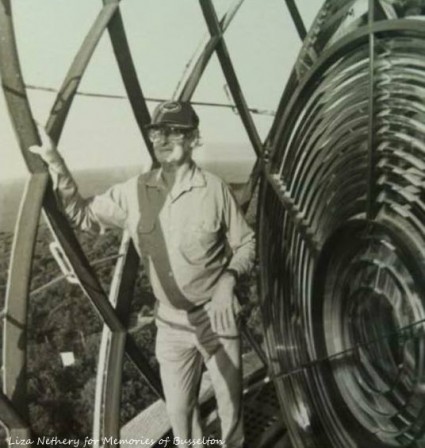
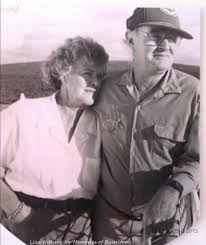
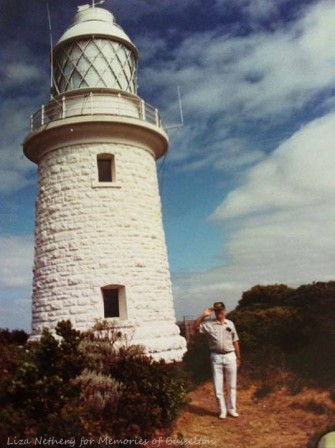
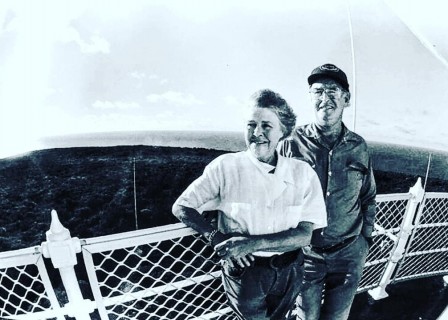
Photos taken my Max and Joan's daughter Liza for a history of the lighthouse at Cape Naturaliste
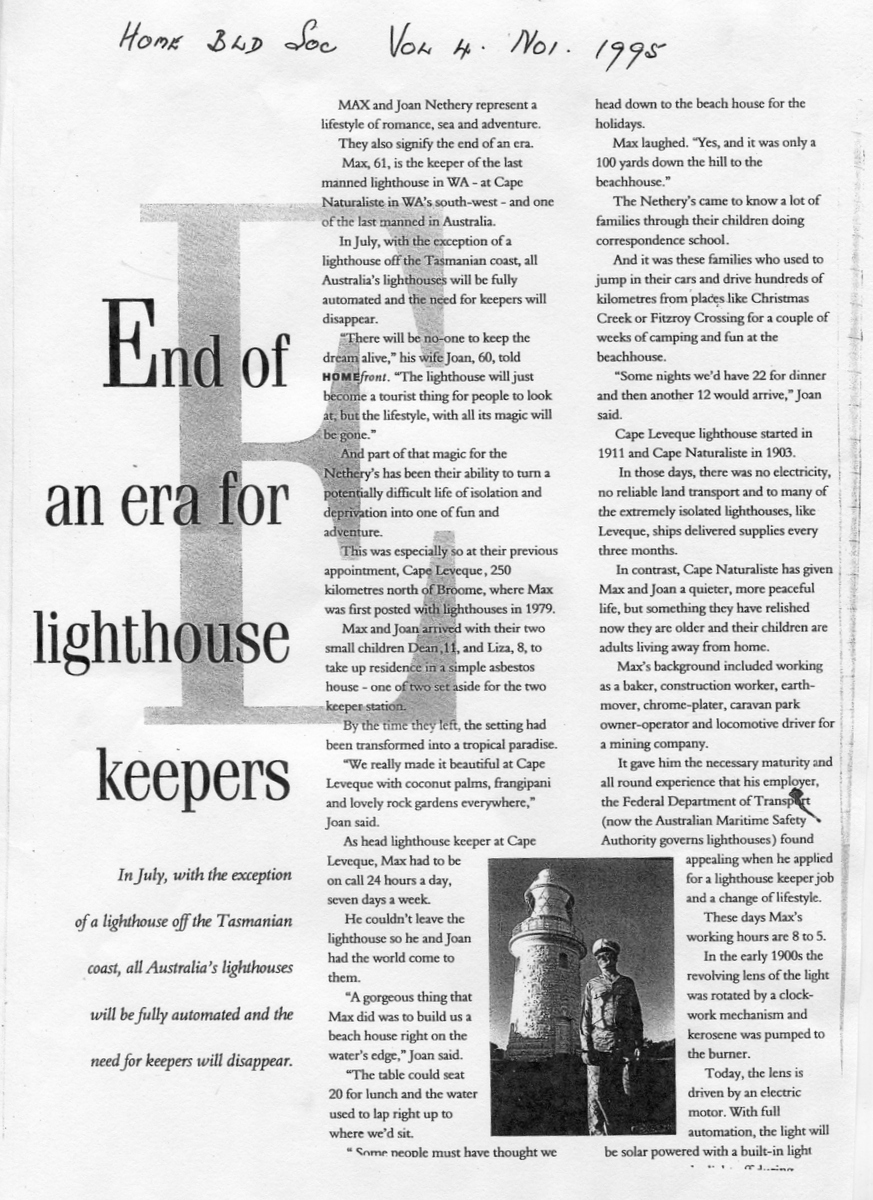

This article was found in a set of family history papers kept by Eric Nethery who was Ian's Grandfather, Mervyn Nethery's borther. This makes Eric Nethery, Max Nethery's uncle. The papers were passed on to Ian Ralph following Elaine Ralph's death.
Monday 9th April 1990
There was no need to hurry our departure today as Yvonne and Michael, with whom we are planning to stay for the next few days, wouldn't be home until around 6:30 to 7:00 PM [2020 note: Yvonne went to school with Jacqui at Elanora Primary and Narrabeen Girls High School]
After I washed our car, Max and I noticed drops of automatic transmission fluid (ATF) on the drive. Closer inspection revealed the whole underside of the car covered with the stuff and when I started it up it began dripping furiously. It looked as though I may have to take the car to a mechanic as we wouldn't get to Perth if the car continued to lose ATF at that rate. A closer inspection revealed the source of the leak. It was a split in the rubber hose that joined the aluminium cooling tubes to the transmission housing. Cutting out the split section of the hose partially cured the problem.
We got away from the Cape Naturaliste Lighthouse at 12 midday and went into Dunsborough where I bought a new length of hose for the transmission. At the PO we picked up a huge bag of correspondence material for Lachlan. We were surprised to see Max in town - he had brought his car in to have its wheels aligned.
From Dunsborough we drove north through light rain, on a flat road which, most of the time, crossed sandy scrub and sheep farms. At Busselton, in a beachside parking area, Jacqui and the kids ate ice creams while I parked the car with one set of wheels on the gutter allowing me to slide underneath and replace the transmission hose. When I finished the job, we left hastily having deposited a sizebale pool of ATF in the carpark.
In the dusk, as we drove through Perth’s southern industrial area, we saw bright yellow flames flaring on top of tall smokestacks in the petroleum refineries. The buildings looked festive, aglow with bright yellow lights.
Arrived at Yvonne’s just on dark we parked the van in a lane, unpacked and gulped down a cup of tea. Dinner that night was a at Mexican restaurant where we drank and ate to excess.
Tuesday 10th April 1990
Yvonne and Mike had left for work by the time we got up. After breakfast I rang around and organised to have the front damper units on the car replaced at 11:30 AM in Cannington.
We found the repairer’s workshop without difficulty and spent the next 2½ hours in the carousel shopping centre before returning, only to find that they needed another 3/4 of an hour to finish the job - which they did not do very well as you will see. This extra time was spent in the local council park.
Back at Yvonne’s we washed and prepared dinner, as it was today we had chosen to celebrate Anja’s 4th birthday.
Yvonne and Mike had been at a managers meeting, drinking champagne and eating sandwiches, so they weren't hungry.
Jacqui had made a cake and Anja had a good time with all her gifts from Jo (Jacqui's mum), Nicky (Jacqui's sister), Owie and Georgie and not to mention mum and dad.
Peter and Sue from Yvonne’s and Mike’s business, came around for a few hours. After more gasbagging we got to bed at around midnight. Bere, our friend from Sydney who had helped so much in our house pack-up, rang in the afternoon to tell us that she leaves on her trip on the 1st of May 1990.
Wednesday 11 April 1990
Scott and Paul, whose relationship with Yvonne and Mike is unknown, had been staying with Yvonne and Mike and they too were leaving this morning. They were preparing to travel around Australia in their Toyota Land Cruiser. We swapped ideas as we both packed for our departure. They will be travelling slower and on roads in inaccessible to us in our normal road car, so we are unlikely to see them on the road.
After returning to the Carousel shopping centre at Cannington for groceries we visited Yvonne’s son, Jason, then detoured to another shoptting centre to buy green groceries. All this took time and it was 3:00 PM before we finally headed North on Hwy 1.
At around 5:00 PM and 230 kilometres North of Perth we pulled into a rest stop with lots of “NO camping” signs where the word “NO” had been blacked out by other campers. We joined two other groups camping there who also, apparently, couldn't read!
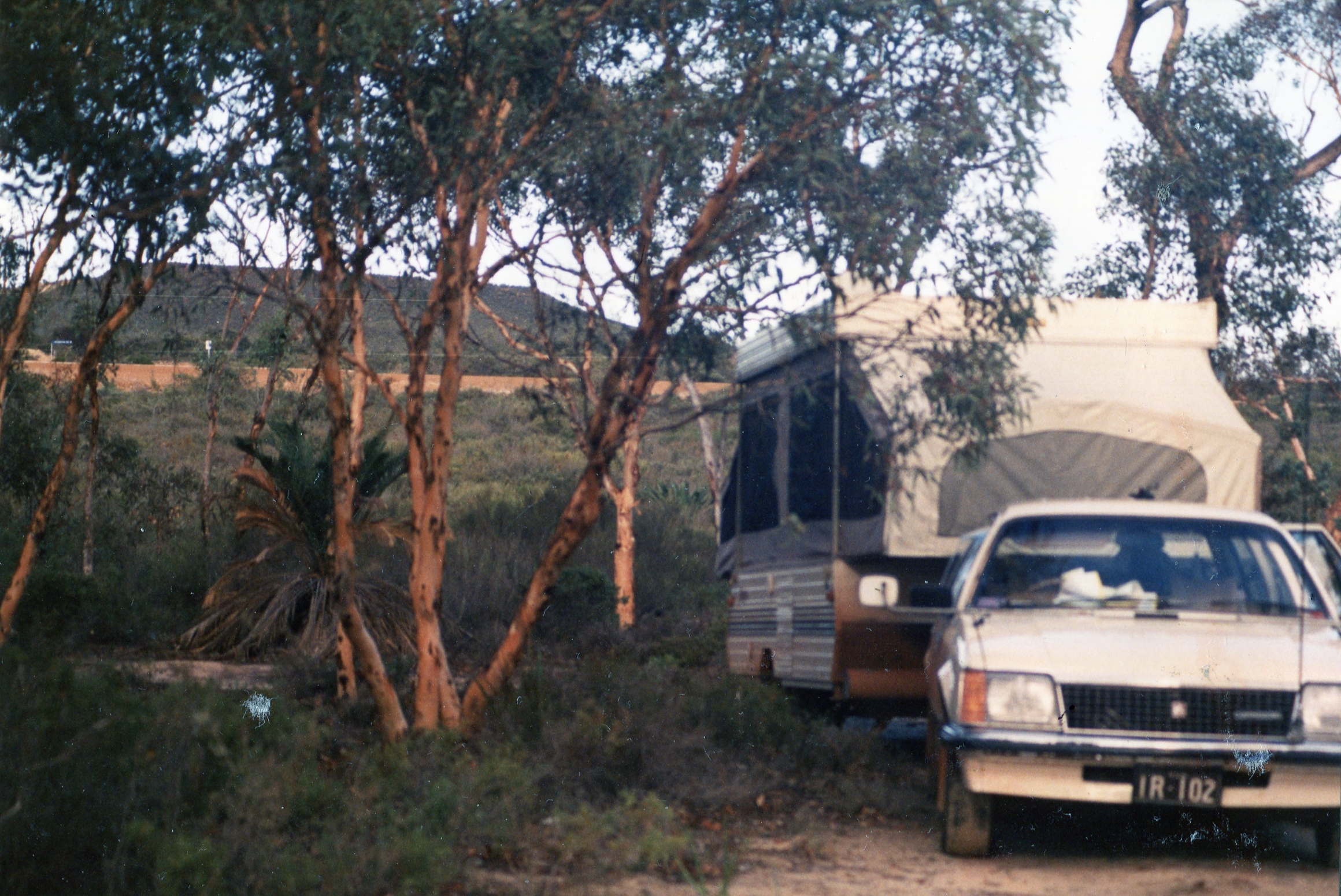
As I write, the road is very busy with lots of car traffic heading North escaping Perth early for Easter adding to the numerous road trains.
Thursday 12th April 1990
After sleeping in until 7:30 AM we didn't get away until nearly 9:00 AM. We needed to sleep a bit longer today after several late nights.
The day was clear and cool with a brisk southwester providing a welcome tailwind. The road was wide and well-made as it curved and bobbed through quite hilly country – at least hilly by Nullarbor standards.
At Dongara we bought fuel and then drove on to Geraldton. Here we feasted on tiger prawns with fresh bread and beer (lite, in case you were wondering), in a bush park opposite the local high school. At one stage we heard a PA address which said, “somebody Smith report to Mr so and so and the Holidays have been cancelled!” There’s always a comic in every school.
After compulsory town stuff, which included getting money and visiting the post office, we headed North again. Each town we passed had a huge grain silo giving the clear impression that wheat plays an important part in the local economy. [2020 note: Nicky’s partner, Peter, grew up on a wheat farm at a place called Three Springs which is southeast of Geraldton.]
It didn't take long to reach our destination on the banks of the Murchison River. Here there is a labyrinth of camping spots on both sides of the river, each with a picnic table and garbage bin. We found a reasonably level site and were set up by 5:00 PM.
The Murchison River next to our site was about 50 metres wide, shallow, and quite slow moving. It is choked by algal growth of the green stringy type which mats on the surface and goes a yucky brown when exposed to the air. A disappointment as we would have liked to swim, although the southwest wind is still strong and cool. Jacqui says it's freezing!
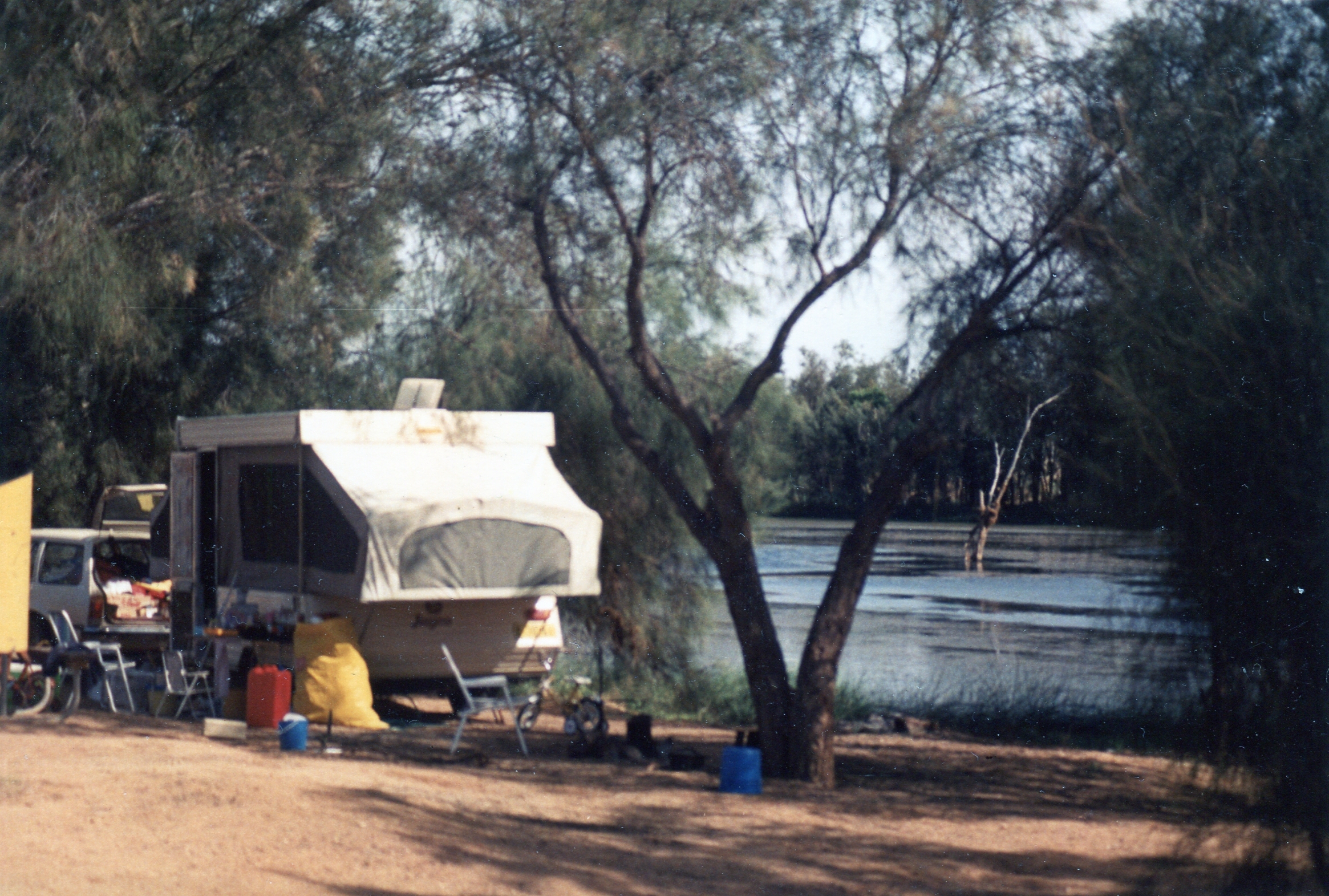
Our campsite on the Murchison River. The river was choked in algae
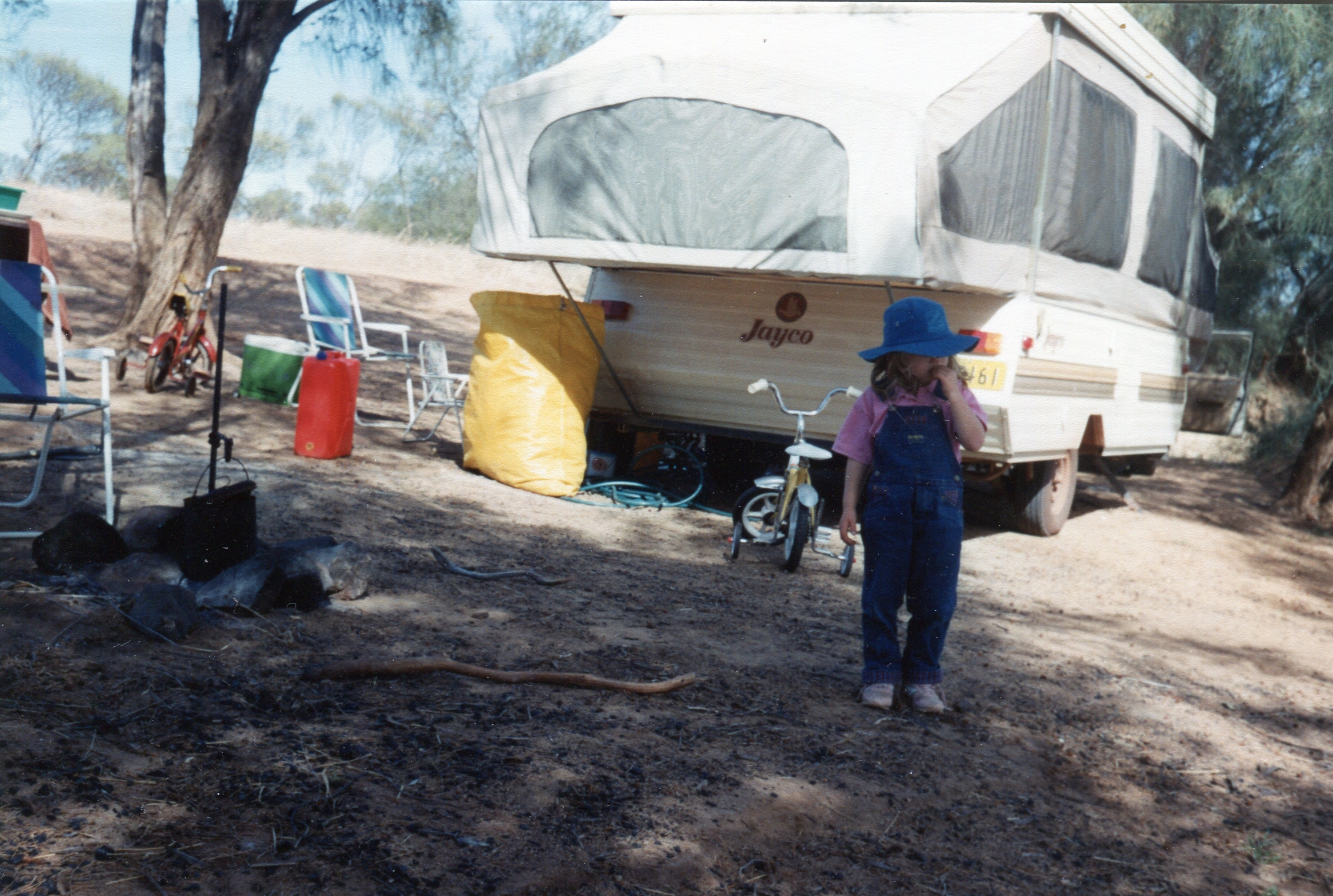 Lachlan took this with an Olympus Trip 35mm camera given to the kids by their grandparents.
Lachlan took this with an Olympus Trip 35mm camera given to the kids by their grandparents.
Friday 13th April 1990
The morning was spent reading, walking and fishing. Some young people arrived in an old HQ Holden station wagon. They showed us that the small bream in the river could be caught. We tried without success. How unusual!
After lunch we drove into Kalbarri stopping along the way to view the Murchison as it flowed lazily through a sandstone gorge.
The road through the Kalbarri National Park was lined with tall banksias and other shrubs, head and shoulders above the low heath of the rest of the park away from the road's edges. Our hypothesis is that the runoff from the road keeps these trees growing whereas the rest are starved of water.
Kalbarri itself is a small holiday, come, fishing village at the mouth of the Murchison River. It was quite busy as today is Good Friday.
Moored in the River were 20-30 largish modern fishing boats of the Steber 34-foot type - similar to the abalone boats we saw in Mallacoota Victoria.
Dashing in and out of these moored fishing boats were sailboards propelled by the wind which was gusting to 30 knots. Hardy souls paddled canadian canoes from the local hire place all over the estuary.
The kids swam but got cold as soon as they emerged due to the wind chill.
From the local phone box I tried to call Alison Anderson, an ex-student of mine from Barrenjoey high school and now a geologist at Mt Tom Price, a but she wasn't home. We are hoping to visit her in the near future.
Next, I looked up Stuart Ralph (Ian’s cousin) and his wife Melinda’s number in Exmouth and organised our visit.
We returned to camp where I cooked fish, baked potato and salad. This was washed down with cheap Murrumbidgee irrigation area wine.
As I write the moon has just risen through the distant scrub, shedding a ghostly light on the tall dead grass and lonely spindly trees.
Saturday 14th April 1990
Dressed, fed and packed in the sizzling time of two hours, meant we were on the road at 8:30 AM heading for Shark Bay and Monkey Mia. It was cool clear, and the strong sou-easterly wind helped us scoot along.
The country was monotonous except when the blue expanse of Shark Bay came into view.
At Denham we filled with food and bought new hats and drove the last 25 kilometres to the dolphin viewing site at Monkey Mia in extra quick time.
A friendly person greeted us explaining how and where to touch the Dolphins. We rushed over to the viewing area and waded into the water up to our knees or chest depending on our height .
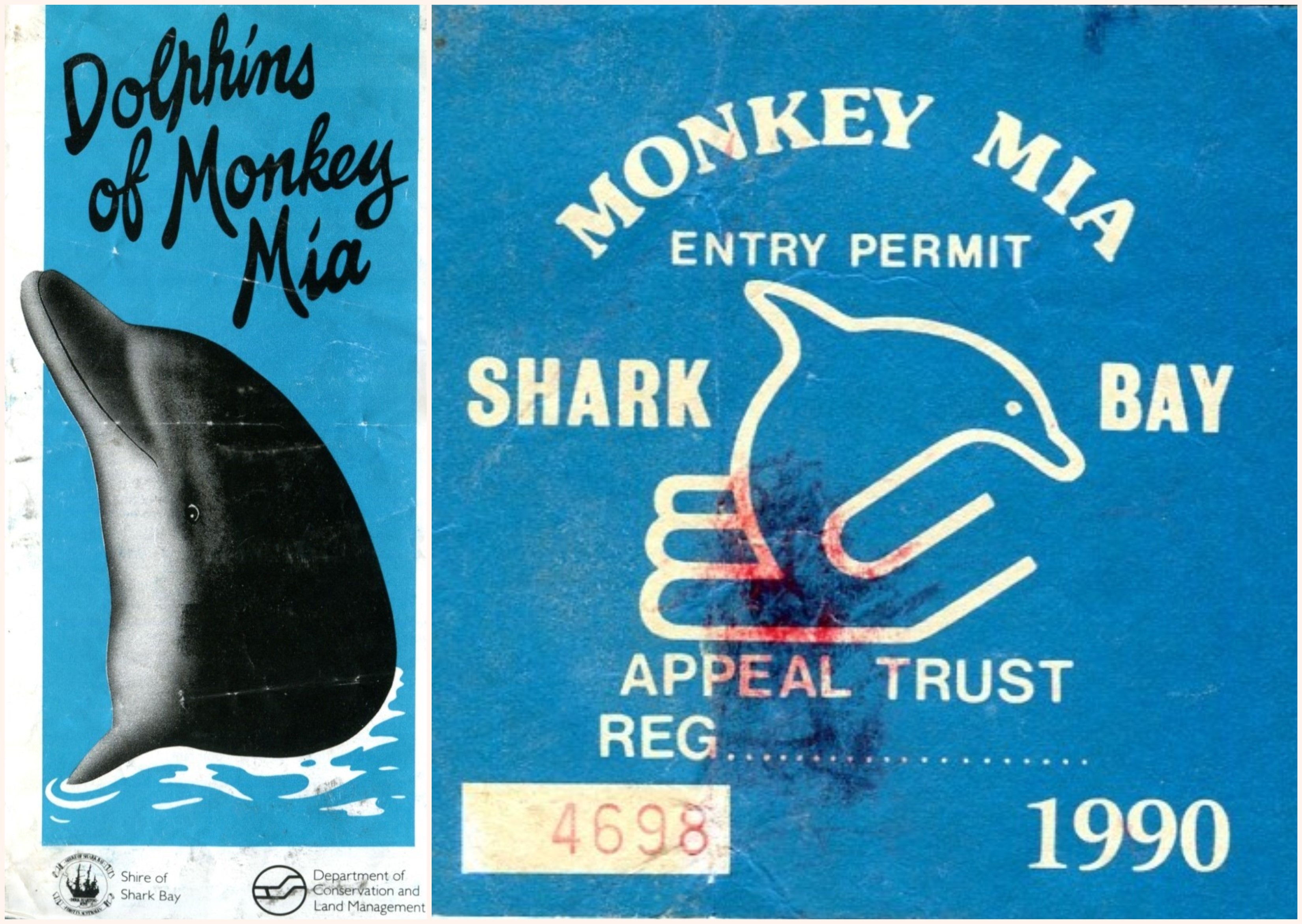
There was one dolphin in at that time and about 20 people crowded around hoping to touch it. The Ranger said she was in a bad mood after making some complaining sounds when touched, so we had to be content with watching. To see a wild creature at such close quarters was great. They swam in so closed they were almost beached.
While we had lunch on the luxurious green lawn of the resort (next to the noise, smoke and red dust of the construction of the new caravan park), the kids swam in the warm clear water.

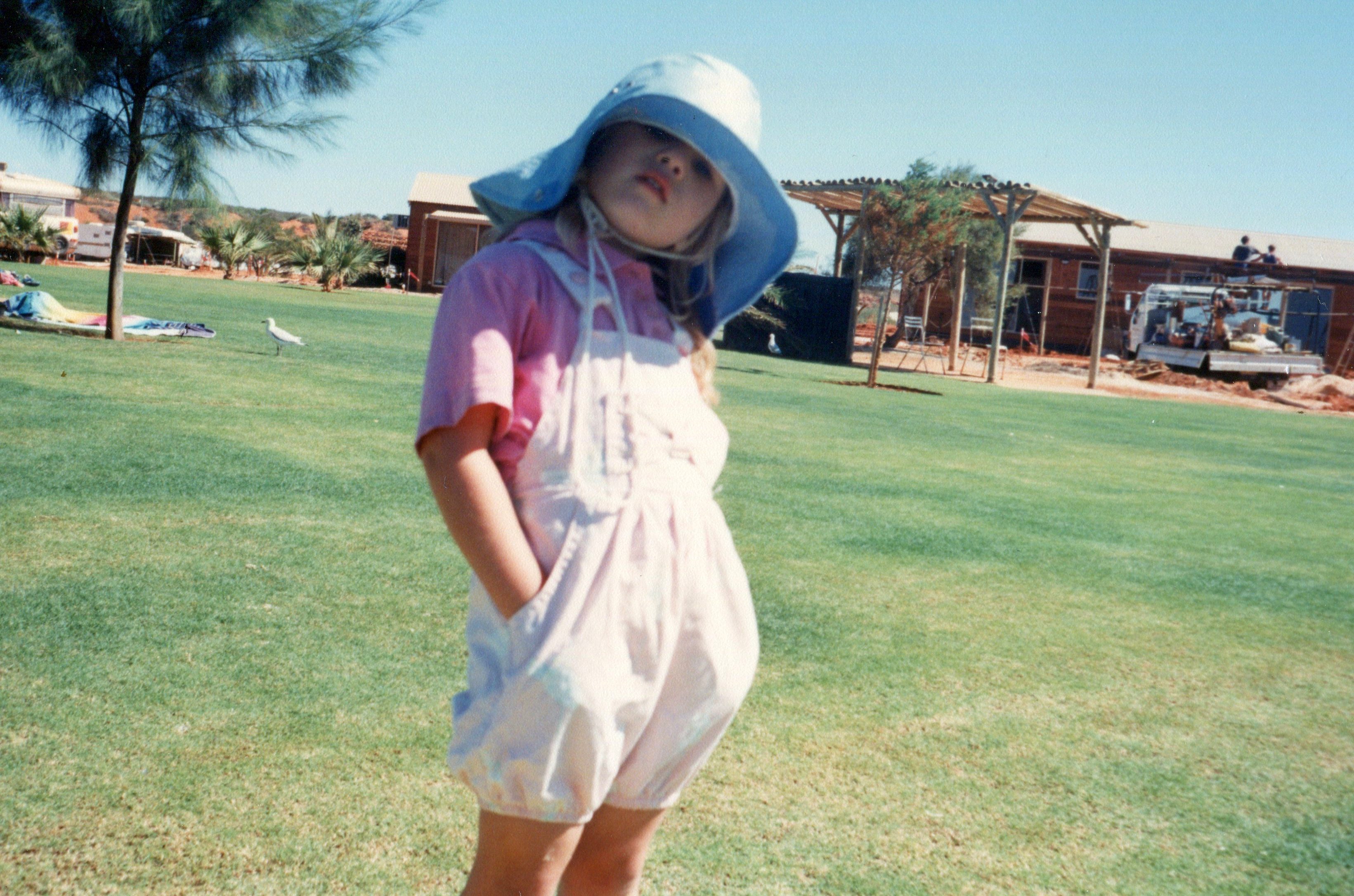
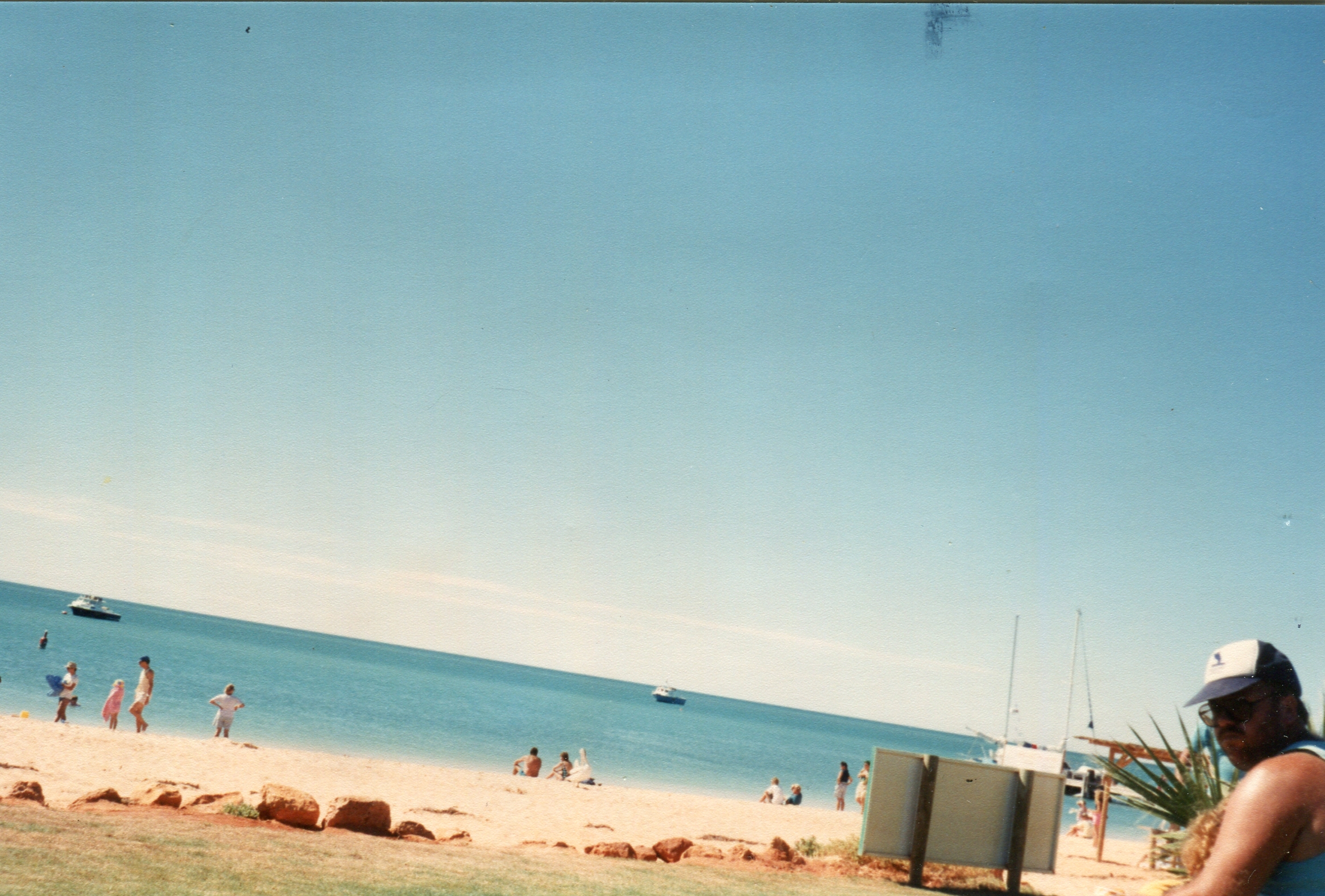
We had lunch on the green lawn of the Monkey Mia resort - one of the kids took these with their Olympus Trip film camera
The car park was full the whole time we were there, yet the viewing area didn't seem unduly crowded.
At 3:00 PM we headed back, this time into the wind and the 164 kilometres back to the overlander Roadhouse, took forever. Turning north again on Highway 1, at Wooramel we got enough fuel to get to Carnarvon. We were disappointed not to be able to camp on the banks of a river near this roadhouse as the rest area was closed.
We headed north again for about 30 to 40 kilometres before turning off on a dirt track that headed west towards Shark Bay.
After 8 kilometres we found a car park at New Beach where we set up camp in the last light of day.
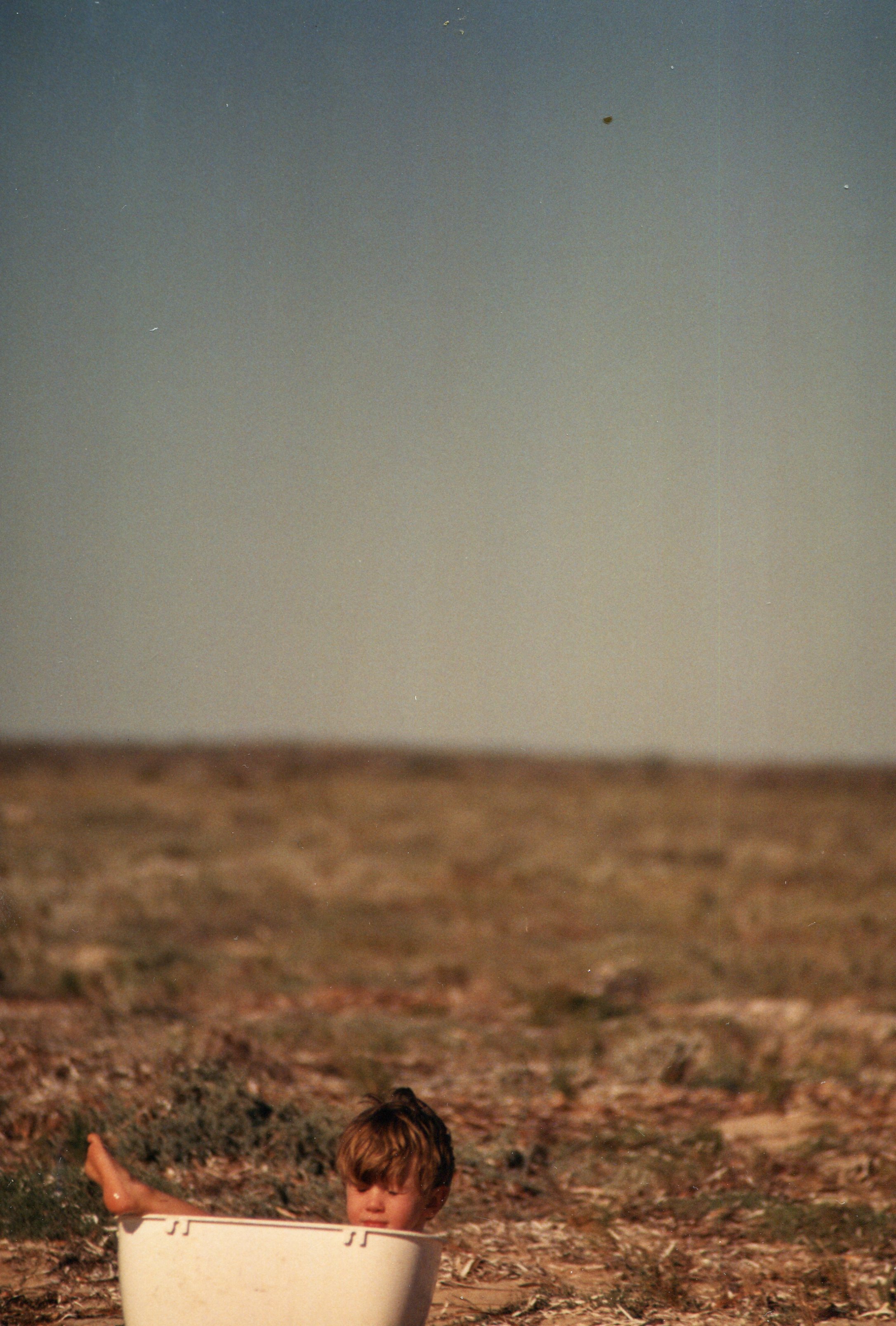
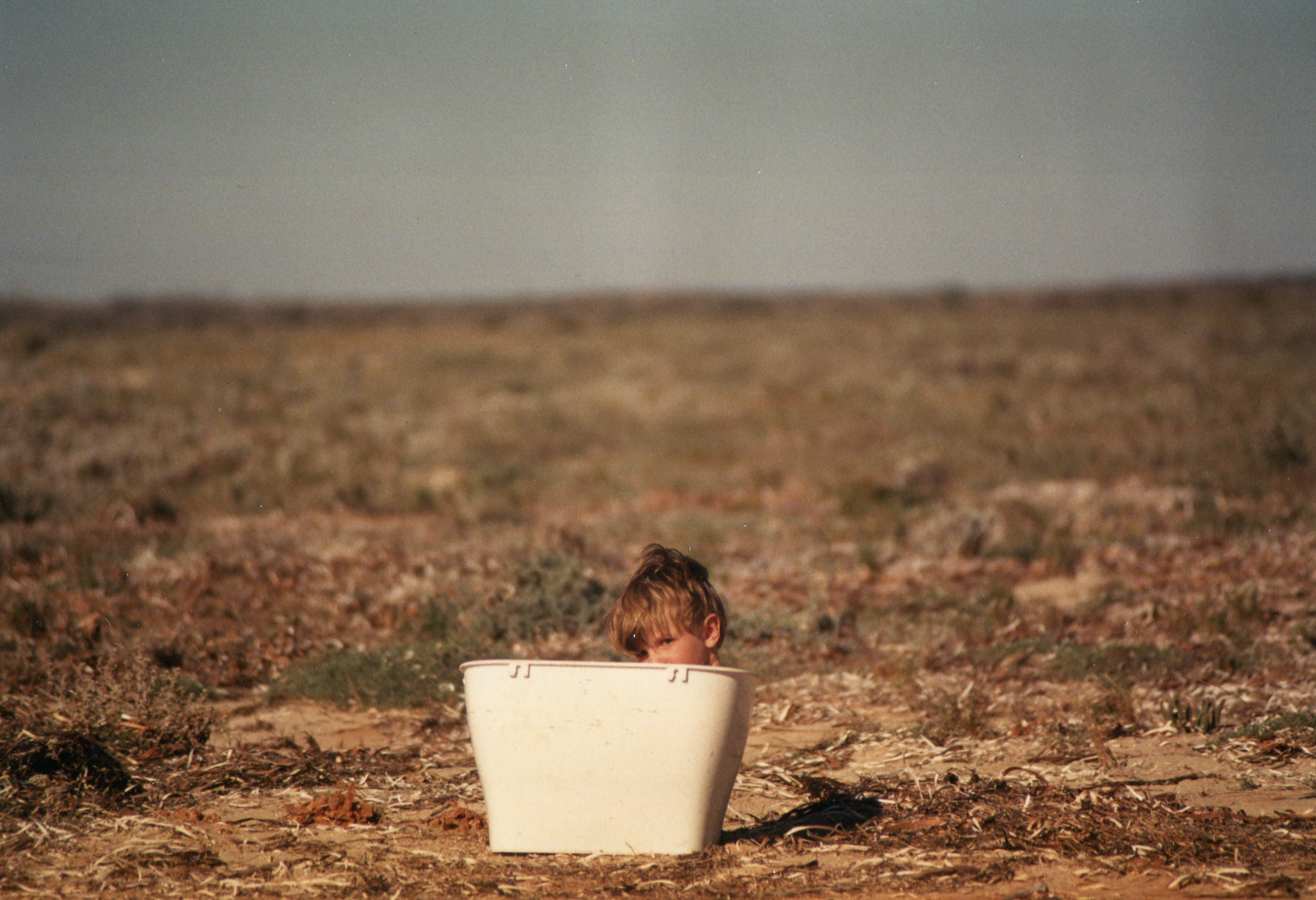
Rohan in our much used portable picnic basket, washing machine and bath.
The wind didn't stop blowing when the daylight faded, in fact as I write, the south side of the van is convex from my point of view and the wind is literally whistling outside while the van creaks and groans.
The kids are excited about the imminent arrival of the Easter Bunny but won't go to sleep so he can arrive!

Mucking around in the van at New Beach
Sunday 15th April 1990 and our 11th Wedding anniversary!
The wind abated during the night and by morning it was merely a gale!
Today, being Easter Sunday, the kids woke early (amazing as they hadn't gone to sleep early) and found the cache of easter eggs that had been left in their beds for them by the Easter Bunny.
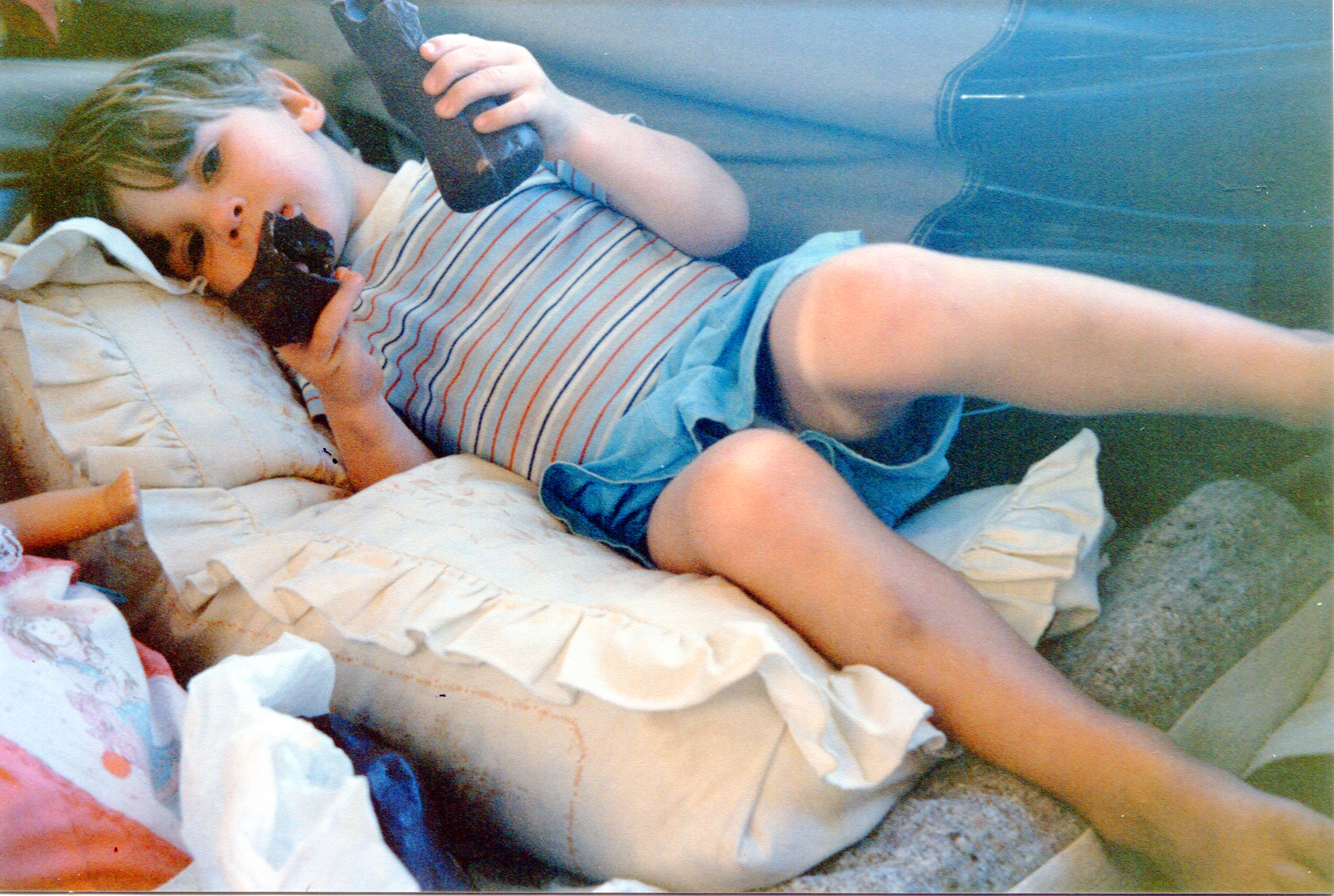
Rohan enjoying a lie-in and his easter egg
During the morning, some Carnarvon locals showed us how to collect worms from the seaweed on the shore. With these worms I was able to catch some very small whiting. Using their flesh for bait I caught a few flathead but they were too small to eat.
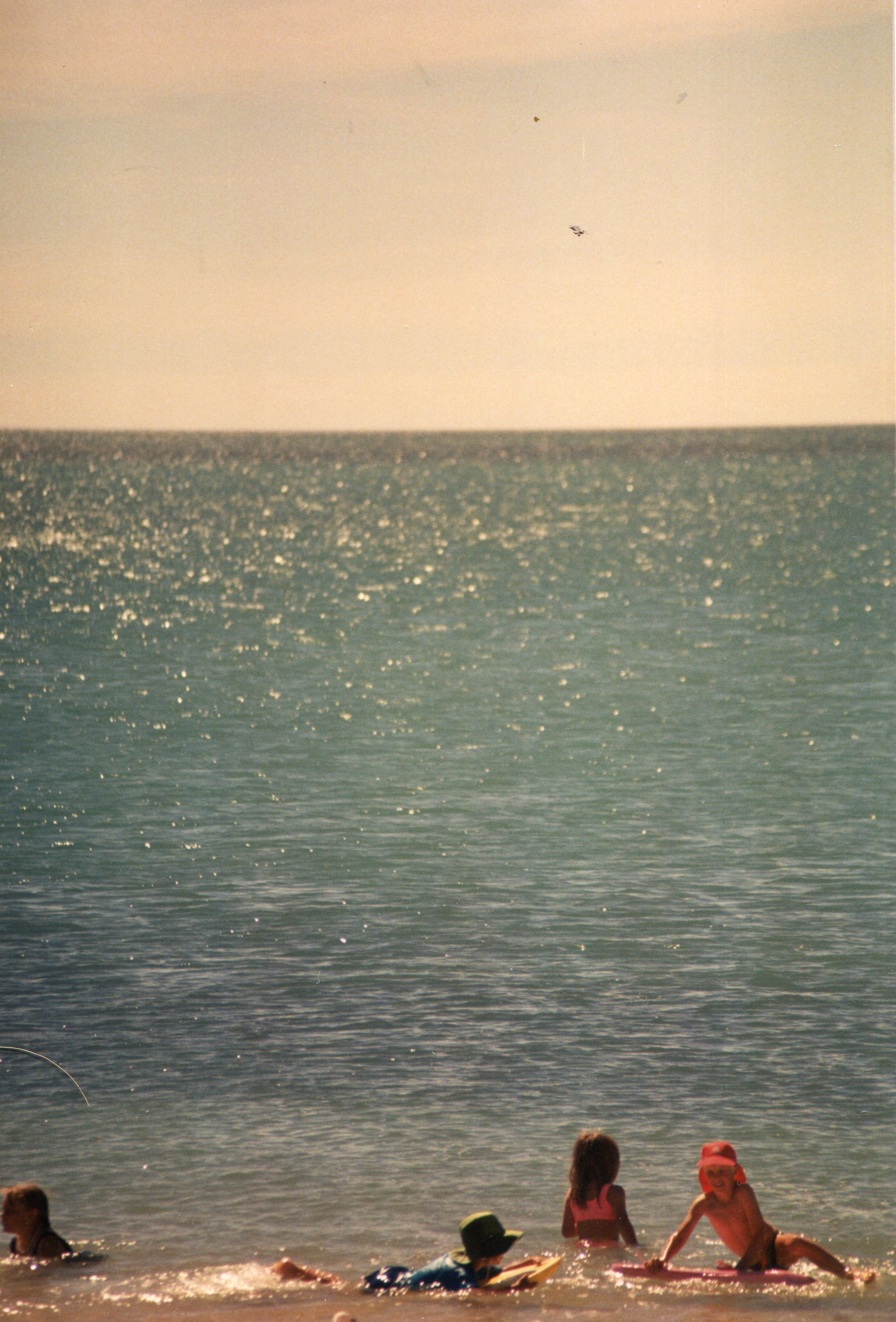
Enjoying a swim in the shallow and apparently shark-free waters off New Beach in Shark Bay
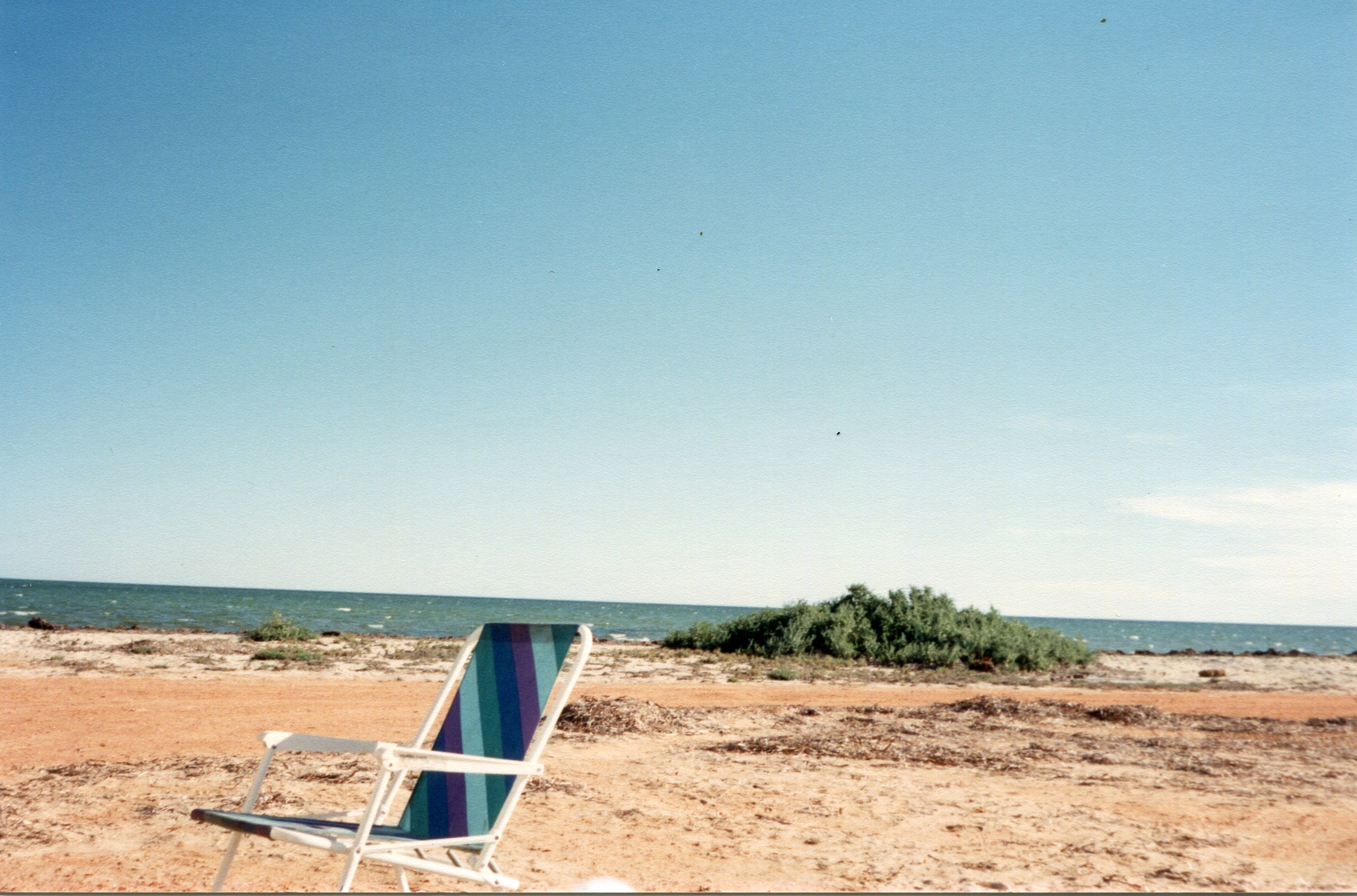
New Beach
The day was spent at leisure, the kids swimming, Jacqui reading and me fishing. A rest day after a yesterday's long day in the car.
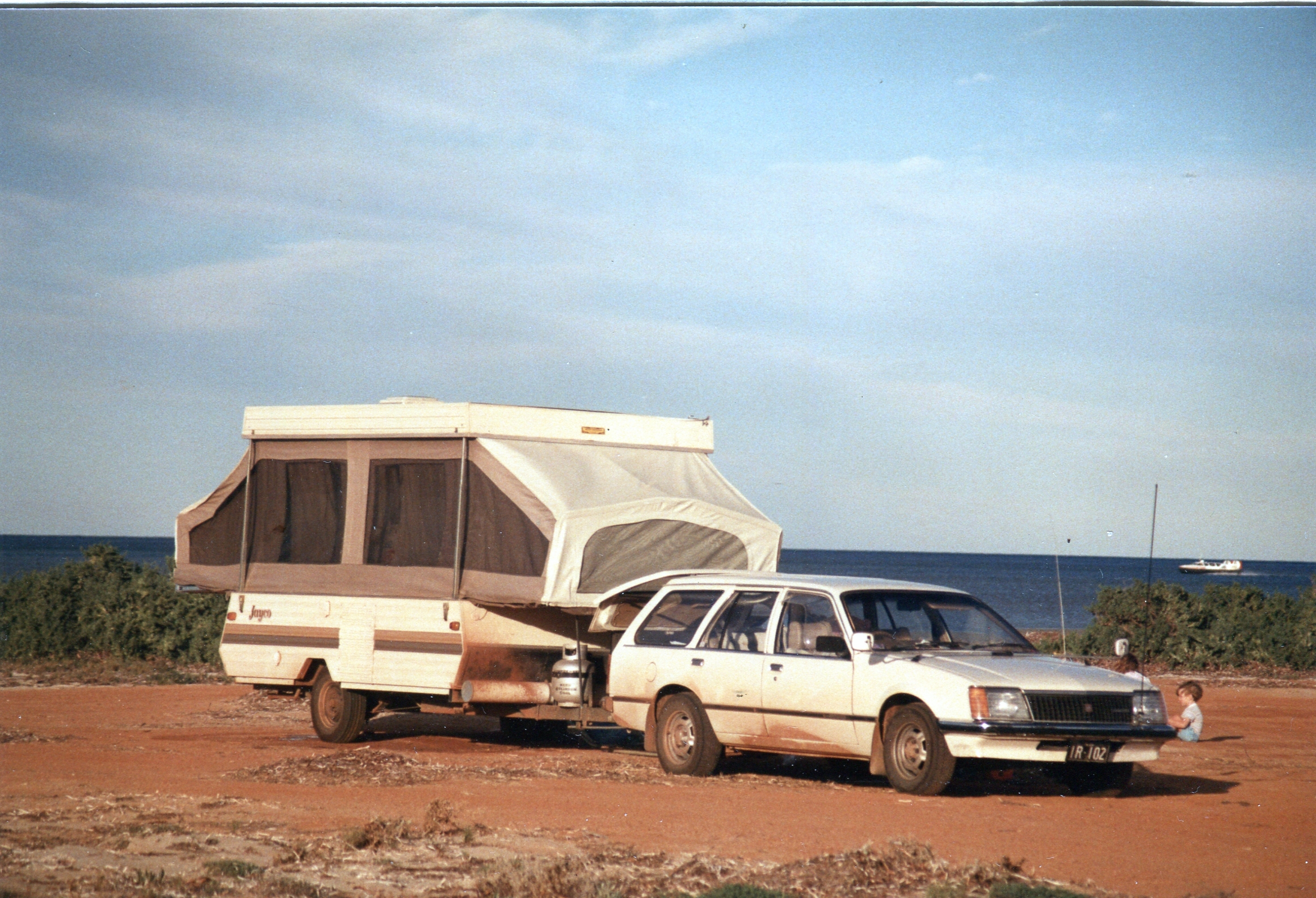
The wind during the night was so strong we had to cover over the ventilation holes for the fridge as the gas flame kept blowing out (2020 note: it was probably just running out of gas.) The hovercraft that takes tourists between Carnarvon and Monkey Mia can be seen.
The only problem was that we ran out of gas in the large cylinder, so the fridge stopped.
Monday 16th April 1990
Up at the amazing time of 6:00 AM, we packed and got away at around 8:00 AM. The day was clear, warm and getting hotter as we travelled north, not so much because we were travelling North, but because the day was simply a hot one.
We filled up with fuel and water at Carnarvon where fuel was cheap. Nearby we saw vast fields of banana trees. We really were in the tropics now.
Near Minilya we came across channel country for the first time. Here the colour of the land changed instantly from brown to green because there was lots of grass. Grass means cattle and cattle, unfenced roads and road trains are not an ideal combination. The roadkill score by the time we were 5 kilometres past the Minilya Bridge roadhouse was cattle zero, road trains 6. At one point 4 cattle, 2 adults and 2 calves, were dead within 50 metres. The smell was terrible!
Turning northwest on the Minilya-Exmouth road, we crossed the 23½ parallel of latitude, or the Tropic of Capricorn.
After bouncing along the worst 8 kilometres of dirt road I have seen, our next stop was Coral Bay. Also bouncing along this stretch of road was John and Sylvia Holden, the ex-working companion of Max at Mt Newman. [2020 note: I didn’t provide any context about John and Sylvia in the diary, or even how we knew who they were. And, as I transcribe the diary, I have no way to add more information about them]
Coral Bay was nice but crowded and commercial. There was no parking at the Coral Bay resort, where caravan parks came right down to the warm, clear water. After a swim to cool us down we again headed north. Between Learmouth and Exmouth we saw lots of radio towers hinting at the military nature of this area.
At Exmouth we called up Melinda Ralph, who gave us instructions on how to get to their new home of six weeks.
Stuart had to work the night shift, so we spent the night talking with Melinda before retiring early.
Tuesday 17th April 1990
After an early morning walk in the warm, muggy, post dawn hour, we spent most of the day waiting at the hospital for Anja to have her ear seen to – she had an inner ear infection. There was one doctor on and lots of people waiting.
Melinda showed us around the area and went to work at 1:00 PM. Stuart slept until 1:30 PM and we worked on an old Kawasaki trail bike he had been given without success - it was dead!
After spending most of the afternoon washing and vacuuming the car, Melinda spent hours showing Jacqui the correct way to cut hair. This was much appreciated by Lachlan and I who got great haircuts.
Links to other posts
In the beginning: Motivation and Planning
NSW: Merry Beach, Bournda State Recreation Area
Victoria Pt 1: Mallacoota - Lakes Entrance, Lakes Entrance - Melbourne
Tasmania: 1st - 18th February, 19th - 27th February
Victoria Pt 2: 28th February - 12th March
South Australia: 13th March - 27th March
Western Australia Pt 1: 28th March - 17th April
Western Australia Pt 2: 18th April - 5th May
Northern Territory: 6th May - 17th May
Queensland Pt1: 18th May - 31st May
Queensland Pt 2 to Sydney: 1st June - 20th June